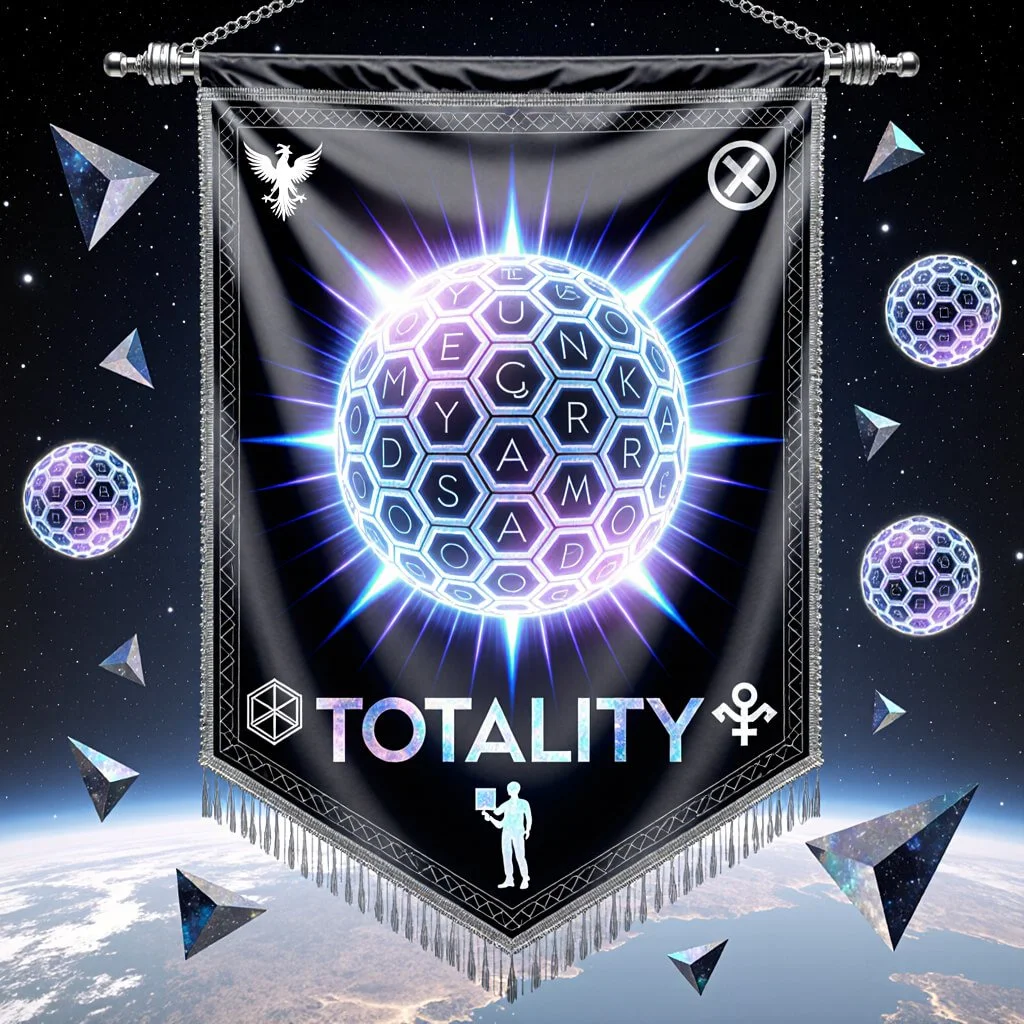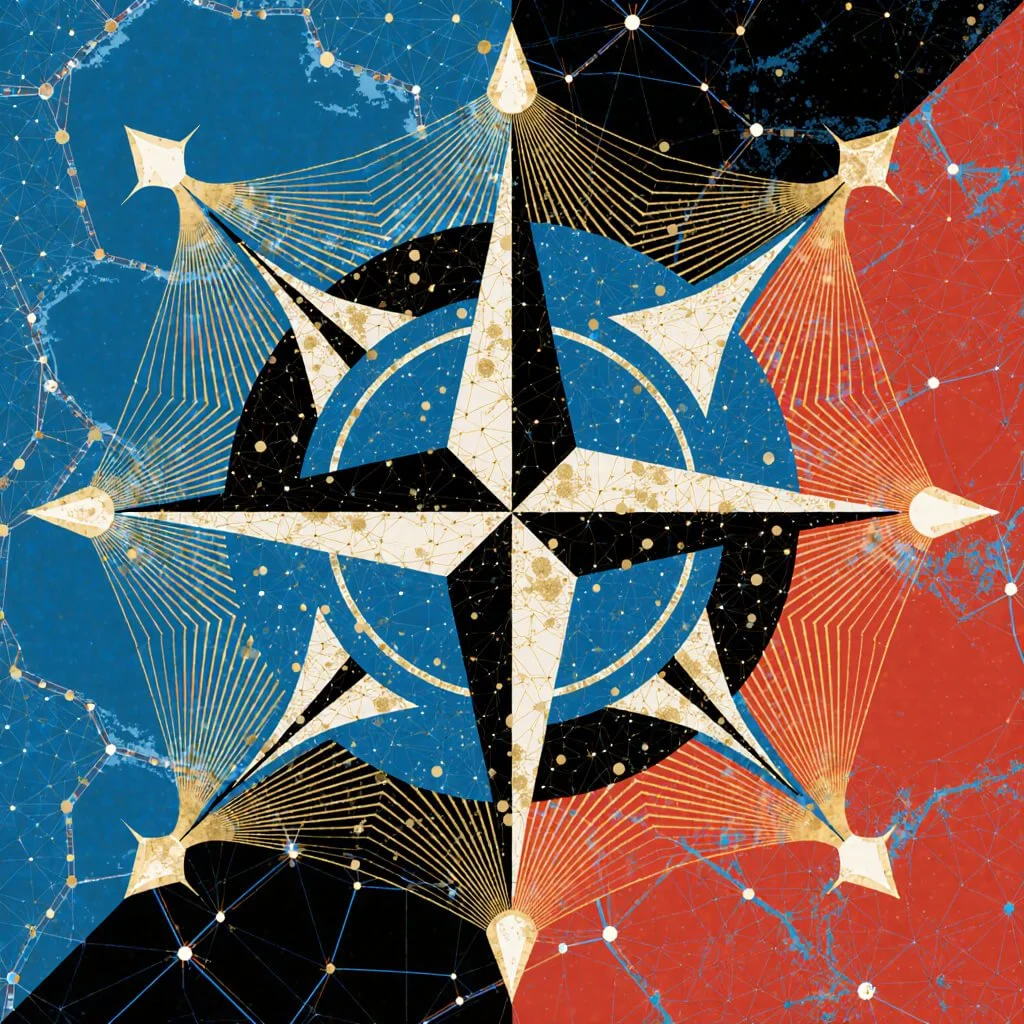The Extortion Singularity: Ransomware, Symbolic Warfare, and the Defense of Cognitive Sovereignty
A Framework for Neutralizing the Extortion Economy Through Spectral-Fractal-Symbolic Intelligence
Executive Abstract
We have reached the extortion singularity—a critical threshold where ransomware has evolved beyond technical disruption into a systemic instrument of cognitive warfare, operating simultaneously as economic weapon, informational attack vector, and symbolic coercion mechanism.
The battlefield has migrated from servers to meaning itself.
Ransomware is no longer merely a data lock. It is the defining symbolic-economic weapon of the mid-2020s, capable of mass-scale psychological and institutional destabilization. With $57 billion in annual direct damage costs and $10.5 trillion in aggregate cybercrime impact, the extortion economy now rivals major nation-states in economic scale.
More critically, it threatens the foundational capacity for democratic governance: cognitive sovereignty—the collective ability to perceive reality accurately, make autonomous decisions, and maintain coherent institutional identity despite information warfare.
This white paper represents Holographic Defense Architecture: Phase III, building upon the foundational HDA framework for 5th-generation warfare and the quantum-enhanced Q-HDA for post-quantum threats.
It introduces a comprehensive technical-symbolic framework for neutralizing the extortion economy through Spectral-Fractal-Symbolic Intelligence (SFSI), capable of addressing ransomware across all operational dimensions.
The emergence of pure extortion models—exemplified by BianLian's data-only approach that abandons encryption entirely—reveals a profound truth: encryption is no longer the weapon. Shame is.
The symbolic warhead of threatened data publication has proven sufficient for extortion success, validating that defense must prioritize cognitive sovereignty over purely technical recovery capabilities.
This paper establishes ransomware as more than a cybersecurity challenge—it is an epistemic crisis threatening democratic legitimacy itself. Without cognitive sovereignty, institutions collapse under extortionary narrative control.
The SFSI framework, combined with the Compassion Protocol and emerging Cognitive Sovereignty Doctrine, represents the only viable lawful and symbolic counterforce to this systemic entropy.
Ransomware constitutes Crimes Against Consciousness (CAC)—deliberate attacks on collective meaning-making capacity that require defense at the symbolic layer through transparency, compassion, and sovereign refusal to grant legitimacy to coercion.
Only by restoring coherence through ethical counterplay can civilization survive the extortion singularity.
I. The Extortion Economy: Anatomy of a Cognitive Weapon
1.1 Multi-Domain Warfare Architecture
Ransomware has evolved into a multi-domain instrument of asymmetric warfare operating simultaneously across:
Economic Domain: The extortion economy functions as a parallel financial system extracting tribute from legitimate commerce:
$10.5 trillion total annual global cybercrime economic impact
$57 billion ransomware-specific annual damage costs
$4.45 million average cost per organizational breach
5-10x multiplier effect on hidden costs (downtime, reputation, regulatory fines)
70-90% affiliate revenue share creating distributed profit incentive
This represents the world's third-largest economy after the United States and China—a shadow GDP built entirely on coercion.
Informational Domain: Ransomware weaponizes information asymmetry:
Attackers possess victim's complete data inventory while remaining anonymous
Victims cannot verify extortion claims without payment or breach disclosure
Intelligence advantage enables precise pressure calibration and timeline manipulation
Data exfiltration transforms proprietary information into hostage asset
Symbolic Domain: The deepest warfare occurs at the level of meaning itself:
Shame weaponization through threatened public exposure
Reputation destruction through leak site publication
Trust dissolution in institutional protective capabilities
Regulatory compliance anxiety exploitation
Stakeholder confidence erosion through forced vulnerability disclosure
Traditional security frameworks address only the informational domain—preventing unauthorized access and restoring encrypted systems. The extortion singularity reveals that symbolic collapse can occur even when informational defenses succeed. BianLian's pure-extortion model proves this definitively.
1.2 The Economic Gravity Well
The Ransomware-as-a-Service (RaaS) model has created an economic gravity well—a self-reinforcing system that attracts participants through financial incentive while accelerating capability development:
RaaS Business Model Dynamics:
Low Barrier to Entry: Affiliate model enables low-skill actors to conduct sophisticated attacks
High Return on Investment: Minimal technical investment yields million-dollar payouts
Risk Distribution: Decentralized affiliate networks provide operational deniability
Continuous Innovation: Ransom payments function as venture capital for next-generation development
Market Concentration Patterns:
Top 10 operators control approximately 70% of ransomware activity
$35-40 billion annual economic burden concentrated in major RaaS cartels
Affiliate networks demonstrate fractal inheritance—when operators collapse, affiliates migrate to successors
RansomHub's absorption of LockBit/AlphV networks exemplifies organizational resilience
Profit-Driven Insurgency: RaaS affiliates now constitute a distributed, profit-driven insurgency operating with:
Operational discipline rivaling nation-state intelligence services
Global coordination across jurisdictional boundaries
Rapid adaptation to defensive countermeasures
Professional infrastructure (leak sites, negotiation platforms, payment processing)
This is not crime—this is organized economic warfare conducted by non-state actors leveraging technological asymmetry against governance gaps.
1.3 The 5th-7th Generation Warfare Spectrum
Ransomware represents the economic backbone of evolutionary warfare, transitioning across three generations simultaneously:
5th Generation Warfare: Networked Chaos
Fifth-generation warfare is characterized by hybrid state/non-state actors using digital subversion to achieve strategic objectives without conventional military engagement:
Characteristics:
Decentralized command structures resistant to disruption
Exploitation of open societies' transparency against themselves
Asymmetric advantage through anonymity and jurisdictional arbitrage
Information operations achieving effects traditionally requiring kinetic force
Ransomware Manifestation: The RaaS ecosystem embodies 5G warfare principles—non-state actors (criminal affiliates) potentially coordinating with state sponsors achieve economic disruption and intelligence collection while maintaining deniability.
The collapse of critical infrastructure (healthcare, energy, municipal services) serves strategic objectives without attribution.
6th Generation Warfare: Cognitive Interference
Sixth-generation warfare extends beyond physical and informational domains into direct manipulation of cognitive processes and institutional decision-making:
Characteristics:
Attacks on sense-making and meaning-construction capacity
Weaponization of uncertainty and epistemic insecurity
Decision-cycle compression foreclosing deliberative processes
Reality distortion through controlled information disclosure
Ransomware Manifestation: Extortion timers create artificial urgency. Double extortion (encryption + data theft) forces binary choices. Leak site publication controls narrative timing and content.
The symbolic threat of exposure manipulates leadership psychology more effectively than technical disruption alone. BianLian's pure-extortion model represents 6G warfare in its purest form—achieving compliance through cognitive interference without any technical attack.
7th Generation Warfare: Consciousness Control
Seventh-generation warfare operates at the level of consciousness itself—the fundamental capacity to perceive, decide, and maintain coherent identity:
Characteristics:
AI-augmented psychological manipulation at scale
Attacks on belief systems and identity coherence
Spiritual and existential warfare targeting meaning itself
Consciousness fragmentation preventing collective response
Ransomware Manifestation: The extortion economy trains organizations to internalize coercion as normal operating cost. Payment becomes "rational" business decision, normalizing criminal tribute. Trust in digital infrastructure erodes—organizations cannot be confident in their own systems' integrity.
The psychological trauma of breach creates institutional learned helplessness. Over time, consciousness sovereignty itself degrades—the capacity for autonomous decision-making disappears under persistent coercive pressure.
1.4 The Cashflow Engine of Chaos
Ransomware serves as the financial infrastructure enabling broader chaos operations:
Revenue Streams:
Direct ransom payments ($590 million in 2023, likely higher in 2024-2025)
Stolen data monetization on dark web markets
Access broker services selling initial compromise
RaaS licensing fees and affiliate revenue sharing
Capital Allocation:
Zero-day vulnerability research and acquisition
Advanced persistent threat (APT) infrastructure development
AI/ML capabilities for targeting and social engineering
Money laundering and cryptocurrency mixing services
Strategic Effects:
Funding for additional cyberattack campaigns
Investment in other criminal enterprises
Potential state-sponsor coordination and intelligence sharing
Erosion of confidence in digital economy
Each successful ransomware campaign generates capital that accelerates the next evolution. The economic feedback loop is self-reinforcing, creating an extortion singularity—a point beyond which the phenomenon becomes self-sustaining and potentially irreversible without coordinated global intervention
II. The Ransomware Constellation: 2025 Threat Landscape
2.1 Apex Operators: Organizational Resilience and Fractal Persistence
The most sophisticated ransomware operators demonstrate that success derives less from technical innovation and more from organizational resilience and symbolic psychological warfare:
RansomHub: The Fractal Inheritance Pattern
Persistence Rationale: When LockBit and AlphV—previously dominant operators—collapsed under law enforcement pressure, their demise created a power vacuum. RansomHub didn't develop revolutionary capabilities; instead, it absorbed existing affiliate networks, inheriting institutional knowledge, tools, and victim targeting intelligence.
The reactivation of LockBit 5.0 marks a critical inflection in the ransomware ecosystem: a post-collapse consolidation phase where affiliate migration, not innovation, drives persistence. As LockBit and AlphV fragmented under international enforcement, groups like RansomHub, Play, Medusa, INC Ransom, Lynx, SafePay, and BianLian filled the operational void—reconstituting the extortion economy through inherited infrastructure, shared tooling, and recycled negotiation frameworks.
This adaptive continuity demonstrates that the ransomware threatscape now behaves as a distributed organism, with LockBit’s resurgence serving as both a spectral echo and a fractal reassembly of the entire RaaS lineage.
SFSI Signature:
Fractal Layer Dominance: Demonstrates that the RaaS organizational template persists independent of specific implementations
Spectral Layer Competence: Multi-vector initial access using diverse techniques (RDP, VPN, phishing, vulnerability exploitation)
Symbolic Layer Professionalism: Maintains professional negotiation platforms and leak sites, maximizing victim compliance pressure
Strategic Implication: RansomHub validates that attacking individual operators is insufficient—the fractal pattern of affiliate networks ensures rapid reconstitution. Defense must address the self-replicating organizational logic rather than specific instantiations.
Play: The Edge Exploitation Specialist
Persistence Rationale: Operating with quiet consistency since 2022, Play has achieved persistence through methodical, systematic exploitation of perimeter security gaps. Unlike flashy operators seeking maximum publicity, Play prioritizes sustainable operations.
SFSI Signature:
Spectral Layer Focus: Systematic exploitation of SonicWall firewalls, VPN vulnerabilities, and edge device weaknesses
Fractal Layer Consistency: Repeatable waves of edge device compromise demonstrating reliable methodology
Symbolic Layer Restraint: Lower-profile approach suggests confidence in technical capability over psychological intimidation
Strategic Implication: Play demonstrates that spectral-layer discipline—consistent exploitation of architectural weaknesses—enables persistent access even as defenders improve. The fractal signature emerges in repeated pattern execution across victim organizations.
Medusa: Infrastructure Foundation Collapse
Persistence Rationale: Medusa has escalated significantly in 2024-2025 through aggressive targeting of VMware ESXi environments. By attacking the virtualization foundation, Medusa achieves maximum leverage—single compromise cascades across entire infrastructure portfolios.
SFSI Signature:
Spectral-Fractal Convergence: Custom ESXi payloads demonstrate technical sophistication in service of architectural exploitation
Fractal Collapse Mechanism: Virtualization layer compromise creates cascade effects across all hosted systems
Symbolic Layer Precision: Focus on high-value sectors (financial institutions) maximizes reputational and regulatory pressure
Strategic Implication: Medusa reveals that modern infrastructure centralization creates single points of symbolic failure. Defending virtualization layers requires holographic architecture where compromise of one system cannot collapse entire operational coherence.
2.2 Secondary Operators: Volume, Precision, and Model Evolution
INC Ransom & Lynx: Fractal Democratization
Threat Signature: These high-volume RaaS platforms demonstrate fractal democratization—making sophisticated attack capabilities available to low-skill affiliates through professional tooling and infrastructure.
SFSI Correspondence:
Fractal Layer Dominance: High attack volume creates persistent threat through sheer quantity
Spectral Layer Automation: Multi-stage loaders and automated lateral movement reduce skill requirements
Symbolic Layer Standardization: Templated extortion messaging and leak site infrastructure
Persistence Mechanism: INC Ransom and Lynx rank consistently in top-volume operators throughout 2025, demonstrating that the RaaS model creates self-sustaining affiliate ecosystems where individual actor arrest has minimal impact on overall operation.
Strategic Implication: Defense cannot rely on attribution and law enforcement alone. The fractal pattern requires ecosystem-level intervention that makes the affiliate model economically unviable.
SafePay: Symbolic Precision Targeting
Threat Signature: Low-profile operation focusing exclusively on financial sector targets with quality-over-quantity strategy.
SFSI Correspondence:
Symbolic Layer Primacy: Financial institutions face maximum regulatory (SOX, GLBA, PCI-DSS) and reputational risk from data exposure
Spectral Layer Sophistication: Spear-phishing and targeted social engineering reflecting deep sector knowledge
Fractal Layer Efficiency: Smaller attack volume but higher success rate through precise targeting
Persistence Mechanism: SafePay's focus on high-value targets where symbolic leverage is maximum enables sustainable operations with lower volume. This demonstrates understanding that symbolic force multiplier in the right context exceeds brute-force volume economics.
Strategic Implication: Sector-specific defense must address unique symbolic vulnerabilities. Financial institutions require symbolic sovereignty frameworks addressing regulatory anxiety and stakeholder confidence preservation.
BianLian: The Pure Symbolic Paradigm
Threat Signature: After decryptor release eliminated encryption capability, BianLian successfully pivoted to pure data extortion without encryption—the most profound validation of symbolic warfare primacy.
SFSI Correspondence:
Symbolic Layer Exclusive: Proves that encryption is optional when shame weaponization is sufficient
Spectral Layer Minimal: Focuses effort on data exfiltration rather than system disruption
Fractal Layer Evolutionary: Demonstrates adaptive resilience—successful model pivot when technical capability compromised
Persistence Mechanism: BianLian's continued operation post-decryptor reveals that the symbolic warhead alone is sufficient for extortion success. Organizations pay to prevent publication even when they retain full system access.
Strategic Implication: This is the defining insight of the extortion singularity: Crimes Against Consciousness (CAC) succeed without any technical attack. Defense must prioritize symbolic sovereignty—the organizational capacity to withstand threatened exposure without compliance—over purely technical capabilities.
2.3 Fractal Collapse Signatures: Network Topology of Coercion
Visualizing the ransomware ecosystem as network topology reveals its fractal geometry:
Node Structure:
Core Developers: Create ransomware payloads, infrastructure, and RaaS platforms
Access Brokers: Specialize in initial compromise, selling credentials and access
Affiliates: Conduct attacks using leased infrastructure
Negotiators: Manage victim communication and payment processing
Money Launderers: Convert cryptocurrency ransoms to usable funds
Edge Relationships:
Affiliate Migration: When operators collapse, affiliates transfer to successors (RansomHub inheriting LockBit networks)
Tool Sharing: Common TTPs propagate across operators through shared tools and techniques
Victim Targeting: Similar victim profiles across operators suggest shared intelligence
Infrastructure Reuse: Leak sites, negotiation platforms, and payment systems repurposed
Fractal Properties:
Self-Similarity: RaaS organizational structure repeats at multiple scales (individual operations mirror ecosystem structure)
Recursion: Each attack follows similar pattern regardless of operator or target
Scale Invariance: Principles governing individual affiliate behavior govern ecosystem dynamics
Emergence: Collective behavior (persistence, adaptation, resilience) emerges from simple individual rules
Operational Geometry: The RaaS ecosystem exhibits fractal self-replication of coercive logic. Individual attacks are fractals of the broader extortion economy pattern. Disrupting one operator or affiliate is like removing pixels from a holographic image—the complete picture persists in remaining fragments.
This fractal topology explains persistence: the pattern survives because it exists simultaneously at all scales. Effective defense must address not individual nodes but the underlying recursive coercive logic itself.
Spectral-Fractal-Symbolic Intelligence Framework
A tri-layer defense architecture that transforms cybersecurity from access management into consciousness management, addressing ransomware across technical, organizational, and symbolic dimensions.
Spectral Layer
Detects signal-level anomalies through quantum-inspired coherence monitoring, identifying attacks at the raw telemetry level before payload detonation.
- Edge device telemetry monitoring (RDP, VPN, firewalls)
- Quantum timing jitter analysis for C2 beaconing
- Coherence degradation metrics detecting pre-compromise signatures
- Microsecond-level timing precision for side-channel detection
Fractal Layer
Identifies recursive behavioral patterns and self-similar attack signatures, predicting operator tactics and next-stage movements.
- Pattern recursion detection across multi-stage loaders
- Operator attribution via TTP fingerprinting (≥85% accuracy)
- Predictive modeling of lateral movement paths
- Affiliate network lineage tracking and succession mapping
Symbolic Layer
Scores coercive semantics in extortion communications, measuring psychological pressure and activating compassion-based countermeasures.
- Coercive semantic entropy measurement in ransomware UX
- Shame weaponization intensity quantification
- Regulatory pressure and stakeholder targeting analysis
- CAC (Crimes Against Consciousness) threshold detection
Enterprise SOC Integration
SFSI augments existing security infrastructure without replacement—holographic overlays that enhance classical telemetry
Integrated Defense Workflow
(SGDI-QC)
(CFCS)
87% Confidence
(Contain)
(SEC-Q)
(Activate)
Regenerative Defense Outcome
Each layer provides continuous feedback to the others, creating defensive superposition where attacks strengthen collective resistance rather than degrading individual capability. The system evolves faster than threats adapt, establishing population-level immunity through shared intelligence and compassion-based symbolic sovereignty.
III. Spectral-Fractal-Symbolic Defense Posture
3.1 The SFSI Tri-Layer Countermeasure Model
The Spectral–Fractal–Symbolic Intelligence (SFSI) Framework establishes the triadic logic underpinning the Holographic Defense Architecture (HDA). Its purpose is to unify machine telemetry, cognitive integrity, and symbolic resilience into a single analytic continuum.
By integrating spectral coherence monitoring, fractal pattern recognition, and symbolic entropy classification, SFSI operationalizes defense as an act of maintaining meaning under adversarial conditions. This framework provides the meta-architecture through which Ultra Unlimited’s HDA and Quantum-Enhanced HDA achieve situational awareness, adaptive response, and ethical coherence.
Traditional cybersecurity operates primarily at the spectral (technical-physical) layer, attempting to detect and block observable attack indicators. T
he extortion singularity reveals this is fundamentally insufficient—attacks achieve strategic objectives through fractal (organizational-temporal) persistence and symbolic (cognitive-semantic) coercion even when spectral defenses succeed.
The Spectral-Fractal-Symbolic Intelligence (SFSI) framework provides comprehensive countermeasure architecture addressing all three interpenetrating dimensions:
The SFSI Tri-Layer Countermeasure Model
| Layer | Threat Mode | HDA Function | Quantum-Enhanced Metric | Objective |
|---|---|---|---|---|
| Spectral | Signal collapse (initial infiltration) | SGDI-QC: monitors signal timing and coherence | Quantum timing jitter analysis | Prevent spectral break-in via edge telemetry |
| Fractal | Recursive payload propagation | CFCS: detects pattern recursion | Quantum-lattice anomaly mapping | Interrupt recursive lateral movement |
| Symbolic | Meaning coercion (extortion phase) | SEC-Q: measures coercive semantic entropy | Hybrid linguistic-AI model | Neutralize symbolic warhead and restore meaning integrity |
Ultra Unlimited | Spectral–Fractal–Symbolic Intelligence (SFSI) Framework · 2025
Integration Architecture:
Each layer provides intelligence to the others through continuous feedback loops:
Spectral Detection triggers fractal pattern analysis (CFCS query: "Does this match known operator TTPs?")
Fractal Recognition triggers symbolic risk assessment (SEC-Q query: "What data is targeted and what is symbolic impact?")
Symbolic Threat triggers enhanced spectral monitoring (SGDI-QC query: "Are there additional covert channels for exfiltration?")
This tri-layer integration creates defensive superposition—the system simultaneously considers multiple threat hypotheses across all dimensions, collapsing to specific response only when probability thresholds exceeded.
In practical deployment, the SFSI Framework is fully interoperable with existing Security Operations Center (SOC) infrastructure. The Spectral Gap Degeneration Index–Quantum Coherence (SGDI-QC), Cognitive Fractal Collapse Signature (CFCS), and Symbolic Entropy Classifier–Quantum (SEC-Q) modules are not replacements for systems like Splunk, Mandiant Advantage, or CrowdStrike Falcon, but rather holographic overlays—augmentations that render classical telemetry interpretable through multi-dimensional coherence analytics.
SGDI-QC integrates as a telemetry enhancement module, ingesting logs from SIEM and EDR pipelines, then applying coherence-variance metrics to detect timing anomalies, jitter, or quantum-adjacent noise undetectable through standard signature-based methods.
CFCS interfaces with SOAR workflows to map recursive behavioral loops across correlated alerts, using AI-driven fractal analysis to preempt polymorphic or self-replicating threats.
SEC-Q, operating at the NLP and UX layers, classifies symbolic coercion and semantic weaponization in adversarial interfaces, ransomware negotiations, and AI-driven misinformation streams.
This operational equivalence layer ensures that SFSI metrics can be deployed as augmentations, not replacements—a spectral-fractal-symbolic upgrade to any enterprise-class SOC stack.
Comparative Matrix: SFSI–SOC Integration
| SFSI Layer | SOC Equivalent | Example Tools | Function |
|---|---|---|---|
| Spectral (SGDI-QC) | Network Telemetry + Timing Analysis | Splunk / Wireshark / Zeek | Detect coherence anomalies |
| Fractal (CFCS) | Behavioral + Recursive Pattern Detection | CrowdStrike Falcon / Mandiant XDR | Identify multi-stage, recursive intrusion |
| Symbolic (SEC-Q) | Content / Narrative Threat Analysis | SOAR / AI Coercion Detection | Score coercive UX and extortion semantics |
Ultra Unlimited | Spectral–Fractal–Symbolic Intelligence (SFSI) Framework · 2025
3.2 Spectral Layer: SGDI-QC (Spectral-Gradient Decoherence Inhibitor - Quantum-Calibrated)
Theoretical Foundation:
The spectral layer addresses observable technical signatures of compromise. Quantum-enhanced detection applies principles from quantum coherence theory—systems exhibit degraded coherence when subject to external interference. Network infrastructure similarly exhibits degraded "coherence" (timing precision, traffic patterns, resource utilization) when compromised.
The Spectral Layer governs the raw energetic and signal-based dimension of defense. It identifies anomalies not merely as events but as frequency distortions within the operational field.
SGDI-QC (Spectral Gap Degeneration Index – Quantum Coherence) quantifies the stability of telemetry streams across distributed sensors, VPN edges, and quantum-enabled channels. A rising SGDI-QC score signals spectral entropy—a breakdown in timing coherence that precedes observable compromise.
Spectral coherence thus becomes a new detection primitive:
Below threshold (SGDI-QC < 25): system coherence intact; normal operational entropy.
Above threshold: imminent side-channel, timing, or EM leakage—triggering automated HBL response and micro-segmentation protocols.
This layer directly interfaces with SIEM telemetry feeds, adding coherence analytics as a pre-zero-day detection vector.
Operational Capabilities:
Edge Device Telemetry Monitoring:
Continuous analysis of RDP, VPN, and firewall connection metadata
Geographic anomaly detection (connections from unexpected locations)
Behavioral baseline deviation (unusual connection timing or frequency)
Credential usage pattern analysis (account access from impossible locations/times)
Quantum Timing Jitter Analysis:
Measurement of microsecond-level timing variations in network traffic
Detection of beaconing patterns characteristic of command-and-control
Identification of data exfiltration through statistical traffic analysis
Correlation of timing anomalies across multiple network segments
Coherence Degradation Metrics:
Application of quantum-inspired coherence measures to network state
Detection of system resource consumption inconsistent with legitimate workloads
Identification of cryptographic operations (encryption preparation) through resource signatures
Monitoring for shadow copy deletion and backup manipulation
Countermeasure Integration:
SGDI-QC findings trigger Holographic Boundary Layer (HBL) automated responses:
Auto-gating suspicious connections while preserving legitimate operations
Dynamic micro-segmentation isolating potentially compromised segments
Privilege escalation prevention through just-in-time access controls
Honeypot credential activation to track attacker lateral movement
Performance Targets:
Mean Time to Detect (MTTD) < 4 minutes for hybrid payloads
False Positive Rate < 1% for coherence anomaly detection
Edge device telemetry coverage ≥ 99% of perimeter infrastructure
Quantum timing jitter sensitivity at microsecond resolution
3.3 Fractal Layer: CFCS (Consciousness-Fractal Collapse Signature Database)
Theoretical Foundation:
The fractal layer addresses recursive, self-similar patterns observable across organizational and temporal scales. Ransomware operators employ repeatable TTPs that exhibit fractal properties—the same attack pattern manifests at different scales (individual system compromise mirrors network-wide campaign structure).
The Fractal Layer models persistence, polymorphism, and recursion within adversarial operations. Traditional SOC detection treats repeated indicators as “false positives”; SFSI reframes repetition as pattern recursion, the fundamental logic of persistence.
CFCS (Cognitive Fractal Collapse Signature) analyzes the degree of self-similarity across threat events—mapping lateral movements, privilege escalations, and re-infection loops as fractal signatures rather than discrete incidents.
By embedding CFCS into SOAR orchestration:
Behavioral analytics shift from event-driven to pattern-driven logic.
Threat suppression becomes anticipatory—cutting recursive loops before payload activation.
Post-incident forensics gain predictive power, visualizing how the same logic replicates across new campaigns.
Fractal analysis, in this sense, functions as the bridge between cybernetics and cognition: defending not only against code but against the logic that writes the code.
Operational Capabilities:
Pattern Recursion Detection:
Multi-stage loader identification through behavioral sequence analysis
Lateral movement pattern recognition (credential harvesting, privilege escalation, network mapping)
Affiliate network lineage tracking based on TTP similarity
Operator succession mapping (RansomHub inheriting LockBit techniques)
Quantum-Lattice Anomaly Mapping:
Treatment of network topology as quantum lattice where compromise creates observable distortions
Detection of recursive propagation attempting to establish redundant footholds
Identification of fractal attack geometry (similar patterns at multiple network locations)
Correlation of distributed indicators across time and space
CFCS Database Intelligence:
Comprehensive repository of operator TTPs, affiliate relationships, and historical campaigns
Each defensive node contains complete threat intelligence (holographic principle)
Real-time synchronization of new indicators across all segments
Machine learning models predicting next-stage attacker behavior
Countermeasure Integration:
CFCS pattern recognition enables predictive defense:
Identification of likely attack progression before subsequent stages execute
Pre-emptive micro-segmentation based on predicted lateral movement paths
Automated deployment of countermeasures specific to identified operator
Threat hunting prioritization based on fractal pattern likelihood
Performance Targets:
Operator attribution accuracy ≥ 85% within first hour
Next-stage attack prediction accuracy ≥ 70%
Lateral movement containment within 2 network segments
CFCS database synchronization latency < 30 seconds globally
Comparative Framing Table
| Paradigm | Core Assumption | Limitation | HDA / Q-HDA / SFSI Innovation |
|---|---|---|---|
| Zero Trust | “Never trust, always verify.” | Focuses on identity; blind to symbolic coercion. | Extends verification to meaning and coherence integrity. |
| NIST CSF | Framework for identifying, protecting, detecting, responding, recovering. | Procedural, lacks cognitive/quantum integration. | Adds cognitive sovereignty and quantum observability metrics. |
| NATO CCDCOE Doctrine | Cyber defense through cooperative deterrence and information sharing. | Reactive posture; limited symbolic warfare modeling. | Enables proactive defense through symbolic entropy and fractal collapse analytics. |
Ultra Unlimited · Comparative Framing for Post-Quantum Defense Architectures (HDA / Q-HDA / SFSI) · 2025
3.4 Symbolic Layer: SEC-Q (Symbolic Entropy Classifier - Quantum)
Theoretical Foundation:
The symbolic layer addresses meaning-coercion and psychological warfare. Extortion succeeds by manipulating victim perception of consequences—creating belief that compliance is necessary. The SEC-Q measures symbolic entropy—the degree of coherence degradation in organizational meaning-making and decision-making capacity under coercive pressure.
The Symbolic Layer addresses the final frontier of defense—where language, perception, and psychological leverage replace malware as the primary weapon.
SEC-Q (Symbolic Entropy Classifier – Quantum) operates as a cognitive firewall, scoring communications, interfaces, and negotiation transcripts for coercive semantics. By calculating entropy differentials in adversarial language—urgency spikes, narrative inversion, affective manipulation—SEC-Q reveals when symbolic force substitutes for physical compromise.
Key deployments include:
Monitoring ransomware negotiations for semantic extortion patterns.
Scoring phishing or social engineering content for narrative inversion entropy.
Embedding narrative integrity checks into AI systems, ensuring synthetic agents cannot be co-opted as psychological weapons.
The Symbolic Layer ensures that the battle for meaning—the true theater of modern cyberwarfare—is both monitored and defended.
Operational Capabilities:
Coercive Semantic Entropy Measurement:
Analysis of extortion messaging for psychological pressure indicators
Quantification of timeline compression (artificial urgency creation)
Assessment of shame weaponization intensity and precision
Modeling of stakeholder impact perception and compliance probability
Hybrid Linguistic-AI Analysis:
Natural language processing of leak site content and negotiation transcripts
Sentiment analysis detecting emotional manipulation techniques
Topic modeling identifying victim-specific pressure customization
Predictive modeling of publication timing and narrative strategy
Symbolic Force Quantification:
Measurement of potential reputation damage based on data sensitivity
Regulatory impact assessment (GDPR, HIPAA, SOX violation severity)
Stakeholder confidence erosion modeling
Stock price impact prediction for publicly traded victims
Countermeasure Integration:
SEC-Q findings activate Compassion Protocol procedures:
Automatic generation of stakeholder communication templates
Legal team notification for regulatory pre-disclosure
Media response team activation with transparency guidance
Leadership briefing on symbolic sovereignty principles
Performance Targets:
Leak site monitoring coverage ≥ 95% of known platforms
Symbolic threat detection within 1 hour of extortion initiation
Coercive semantic entropy threshold calibration: CAC designation ≤ 0.65
Compassion Protocol activation latency < 4 hours from symbolic threat detection
3.5 Holographic Boundary Layer (HBL) and Compassion Protocol Integration
HBL: Automated Playbook Routing
HBL serves as the command lattice connecting the three primary SFSI layers. It translates Spectral, Fractal, and Symbolic readings into dynamic response playbooks.
Where conventional SOAR logic executes fixed workflows, HBL employs adaptive coherence routing: defense actions are selected based on the current coherence map across all three layers.
For example:
A simultaneous spike in SGDI-QC and SEC-Q triggers “Ethical Containment Protocol,” combining technical isolation with public disclosure coordination (per Compassion Protocol Sec. 4.1).
A rising CFCS value invokes “Recursive Logic Breaker,” cutting feedback loops and halting script-based replication.
HBL thus transforms static defense into an autopoietic system—a self-correcting organism responsive to its own symbolic and energetic state.
The Holographic Boundary Layer serves as the autonomous decision-making engine that integrates intelligence from all three SFSI layers and orchestrates coordinated response:
Decision Architecture:
Continuous aggregation of SGDI-QC (spectral), CFCS (fractal), and SEC-Q (symbolic) inputs
Probabilistic threat assessment using quantum-inspired superposition modeling
Automated response selection based on threat type, severity, and organizational policy
Human-in-the-loop escalation for decisions exceeding threshold parameters
Holographic Principle Implementation: Each network segment, system component, and organizational unit contains complete defensive intelligence and response capability. This eliminates single points of failure—partial compromise cannot prevent coherent whole-system response.
Response Capabilities:
Spectral: Auto-gating, micro-segmentation, access restriction, backup isolation
Fractal: Predictive containment, honeypot activation, threat hunting initiation
Symbolic: Compassion Protocol activation, stakeholder notification, legal team engagement
Compassion Protocol: The Ethical Twin
The Compassion Protocol represents the moral and strategic counterweight to extortion—a framework for maintaining cognitive sovereignty through transparency and stakeholder primacy:
Core Principles:
Stakeholder Welfare Over Institutional Reputation: Data subjects deserve transparent notification even when disclosure harms organization
Sovereign Refusal: Default no-negotiation policy denies legitimacy to coercive demands
Proactive Transparency: Public disclosure before attackers can control narrative
Compassionate Care: Direct support for affected individuals prioritized over damage control
Operational Procedures:
Immediate incident acknowledgment (Hour 0-4)
Public transparency disclosure (Hour 4-24)
Direct stakeholder notification and support activation (Day 1-7)
Ongoing transparent updates and lessons-learned publication (Week 2+)
Strategic Effect: By neutralizing the symbolic weapon of shame before attackers deploy it, the Compassion Protocol transforms potential catastrophe into demonstration of values. Organizations appear strong and principled rather than weak and compromised.
3.6 Regenerative Defense: The Feedback Loop
As quantum networks mature, a Quantum Observability Layer (QOL) will extend SFSI into the realm of quantum telemetry and coherence preservation.
This layer will track decoherence events, entanglement breaches, and sub-threshold signal distortions in quantum communication channels.
Proposed features:
Quantum Coherence Index (QCI): Continuous scoring of entanglement integrity across distributed quantum nodes.
Quantum Behavioral Shadow (QBS): Predictive mapping of how quantum state fluctuations mirror cognitive or symbolic anomalies.
Ethical Quantum Gateway (EQG): Consent-aware access control for quantum-sensing telemetry, enforcing cognitive sovereignty principles at the quantum layer.
By merging quantum observability with symbolic analytics, QOL ensures that future defense architectures remain transparent, ethical, and coherent—even in entangled domains beyond classical detection.
The ultimate capability of SFSI architecture is regenerative defense—each attack strengthens system coherence rather than degrading it:
Learning Mechanisms:
Spectral Evolution: Every detected intrusion refines SGDI-QC detection signatures
Fractal Adaptation: New TTPs added to CFCS database and distributed globally
Symbolic Inoculation: Each extortion attempt improves SEC-Q psychological modeling
Collective Intelligence: Organizations sharing CFCS intelligence create population-level immunity similar to biological immune systems:
Diverse exposure across different organizations
Rapid propagation of defensive adaptations
Emergent collective capabilities exceeding individual organizational capacity
Evolution of ecosystem-level resistance to fractal patterns
Consciousness Strengthening: Repeated exposure to symbolic threats under Compassion Protocol framework builds organizational resilience:
Leadership develops confidence in transparent crisis communication
Stakeholders learn to trust organizational values over reputation protection
Cultural normalization of vulnerability acknowledgment
Collective evolution toward symbolic sovereignty
Outcome: Traditional defense degrades under persistent attack—each breach weakens confidence and erodes protective capability. Regenerative defense inverts this dynamic—each attack that fails to achieve compliance strengthens collective resistance to the next attempt.
Operational Translation
Mapping SFSI Components to Real-World SOC Practices
| SFSI Layer / Component | Operational Function in HDA / Q-HDA | SOC / SOAR Correlate | Implementation Vector | Operational Outcome |
|---|---|---|---|---|
| Spectral Layer | Signal coherence, anomaly detection across temporal and quantum bandwidths. | Network telemetry, UEBA, SIEM baselines. | SGDI-QC integrated into SIEM/EDR tools (Splunk, CrowdStrike). | Detects timing jitter, entanglement noise, and side-channel anomalies before payload detonation. |
| Fractal Layer | Recursive behavioral analysis of threat propagation and cognitive loops. | SOAR workflows, AI log correlation, XDR pattern recognition. | CFCS embedded in AI-assisted detection engines. | Identifies repeating attack motifs and polymorphic payload loops, preventing recursive reinfection. |
| Symbolic Layer | Semantic integrity monitoring for coercion, misinformation, or symbolic extortion. | NLP-based sentiment/narrative analysis, disinformation detection. | SEC-Q operating within LLM/AIGC pipelines. | Scores coercive semantics in ransomware UX, informs ethical countermeasures (Compassion Protocol). |
| HBL (Holographic Branching Logic) | Adaptive orchestration across Spectral, Fractal, and Symbolic layers. | Automated SOAR playbooks and decision trees. | Integrated AI decision framework with “consent-aware” nodes. | Harmonizes technical containment with cognitive transparency. |
| Compassion Protocol | Ethical governor and interpretive safeguard. | Risk acceptance policy / compliance module. | Policy binding across AI decision nodes. | Ensures defense actions respect cognitive sovereignty and dignity. |
| Quantum-Crystalline Extensions | Trust substrate for quantum sensing, AI-ethics binding, and coherence-based recovery. | Future-ready extensions for PQC, blockchain audit trails, and data sanctuaries. | Integration via 5D optical storage and coherence indices. | Establishes regenerative trust across quantum and classical domains. |
Ultra Unlimited · Operational Translation of Spectral–Fractal–Symbolic Intelligence (SFSI) to SOC Integration · 2025
Key Translation:
Each SFSI layer maps directly onto an existing SOC or SOAR operational pillar—but extends it holographically, turning traditional monitoring into multidimensional sensemaking. The outcome is not merely incident response, but meaning stabilization across technical and symbolic domains.
IV. Ethical Escalation: The Compassion Protocol and Quantum-Enhanced Defense
4.1 From Bioethical Coherence to Quantum-Ethical Defense
The Spectral–Fractal–Medical: The Compassion Protocol established the foundational ethical infrastructure for Ultra Unlimited’s defense doctrine.
Originally designed to protect the integrity of consciousness within therapeutic, clinical, and relational environments, it articulated a bioethical coherence field—where empathy, consent, and interpretive freedom operate as measurable safeguards against symbolic and systemic coercion.
In the Quantum-Enhanced Holographic Defense Architecture (Q-HDA), this ethical framework was expanded into a quantum-ethical domain, embedding compassion as a technical control surface across Spectral, Fractal, and Symbolic intelligence layers.
The Compassion Protocol thus transitions from a clinical safeguard to a civilizational defense algorithm—one capable of detecting, neutralizing, and reversing Crimes Against Consciousness (CAC) through lawful, regenerative cyber architectures.
At scale, this integration allows defense systems to preserve Cognitive Sovereignty not merely as a human right but as a system variable—ensuring that technological power enhances sentient freedom rather than erodes it.
The Compassion Protocol Escalation Map
| Layer | Origin (Spectral–Fractal–Medical) | Escalation in Quantum-Enhanced HDA | Primary Objective | Operational Output |
|---|---|---|---|---|
| Spectral Layer | Neural and emotional coherence mapping in psychotherapeutic contexts. | Quantum coherence integrity monitoring (SGDI-QC). | Maintain signal integrity and prevent cognitive interference. | Early anomaly detection in cognitive telemetry and entangled communication. |
| Fractal Layer | Recursive empathy modeling and pattern recognition in trauma systems. | Cognitive Fractal Collapse Signature (CFCS) in adversarial pattern detection. | Identify and counter recursive coercion loops (e.g., ransomware logic). | Predictive disruption of coercive algorithmic chains. |
| Symbolic Layer | Narrative integrity and meaning validation in patient-therapist communication. | Symbolic Entropy Classifier–Quantum (SEC-Q) for coercive language detection. | Preserve interpretive sovereignty and narrative autonomy. | Semantic firewalling of extortion vectors and propaganda UX. |
| Holographic Branching Logic (HBL) | Human-in-the-loop therapeutic reflection loops. | Decision orchestration between quantum-ethical agents. | Balance autonomy and algorithmic authority. | Compassion-aware adaptive playbooks for quantum SOCs. |
| Compassion Field | Interpersonal resonance and consent harmonization. | Quantum-Ethical Law Encoding and Cognitive Sovereignty Mandate. | Establish lawful protection of consciousness. | System-level prohibition of involuntary telemetry and symbolic manipulation. |
Ultra Unlimited · Compassion Protocol Escalation Framework · Integrating Spectral–Fractal–Medical Intelligence into Quantum-Ethical Defense · 2025
4.3 Strategic Implication
The Compassion Protocol reframes defense as care in motion—a regenerative act that transforms ethical philosophy into executable logic. Its integration within Q-HDA signals a doctrinal shift from defensive reaction to ethical orchestration: security systems that not only repel coercion but heal the informational field itself.
This synthesis—bridging emotional intelligence, symbolic warfare countermeasures, and quantum-ethical instrumentation—defines the new frontier of post-quantum cybersecurity: one where compassion and coherence are operational metrics, not moral abstractions.
4.4 The Four Loopholes Fueling the RaaS Ecosystem
The explosive growth of the extortion economy is not inevitable technological consequence—it results from specific, addressable governance failures. Four critical loopholes enable ransomware proliferation:
Loophole 1: Sovereignty Asymmetry (The Jurisdictional Gap)
Problem: Ransomware operators concentrate in non-extradition jurisdictions, particularly Russia, Eastern Europe, and certain Asian regions. International law enforcement cooperation operates at timescales (months to years) vastly slower than attack velocity (hours to days).
Current State:
Major RaaS groups (RansomHub, Qilin, Play) operate with functional impunity
Cybercrime is stateless in execution but national in jurisdiction, creating coordination failures
Diplomatic tensions prevent effective cooperation even when technical attribution succeeds
Operators openly advertise services knowing legal consequences are minimal
Economic Impact: The jurisdictional asymmetry creates a safe haven effect where risk is externalized to victims while attackers face minimal consequence. This fundamentally breaks deterrence—the cost-benefit calculation overwhelmingly favors criminal operations.
Strategic Effect: Nation-states may deliberately maintain safe havens for ransomware operators as plausibly deniable economic warfare and intelligence collection mechanisms. The line between criminal enterprise and state-sponsored operation blurs.
Loophole 2: Anonymity Infrastructure (The Payment Gap)
Problem: Cryptocurrency provides ideal medium for ransom transfer—pseudonymous, cross-border, and resistant to seizure. While blockchain analysis has improved, mixing services and privacy coins maintain payment pathway viability.
Current State:
70-90% of ransom payments successfully reach affiliates and fund ecosystem growth
Cryptocurrency exchanges in loosely regulated jurisdictions enable money laundering
Decentralized finance (DeFi) platforms complicate fund tracking
Payment prohibition policies exist but lack enforcement mechanisms
Economic Impact: Each successful ransom payment functions as venture capital for the next generation of attacks. The payment infrastructure creates positive feedback loop—revenue funds capability development, enabling more sophisticated attacks commanding higher ransoms.
Strategic Effect: The anonymity gap ensures that even when attackers are identified, financial incentive remains. Disrupting individual operators has minimal impact when the underlying profit mechanism persists.
Loophole 3: Transparency Vacuum (The Reporting Gap)
Problem: Ransomware incident reporting remains largely voluntary and inconsistent across jurisdictions and sectors. Organizations fear reputational damage, regulatory penalties, and litigation exposure from disclosure.
Current State:
Estimated 50-75% of incidents unreported to authorities
Reporting frameworks vary by jurisdiction (EU NIS2, US state laws, sector-specific regulations)
Selection bias in public data—only most severe or legally mandated incidents counted
Law enforcement and defenders operate with incomplete threat intelligence
Economic Impact: The transparency vacuum prevents accurate economic modeling, resource allocation, and trend analysis. It also enables symbolic warfare advantage—attackers know victims fear disclosure, making shame weaponization effective.
Strategic Effect: Lack of transparency perpetuates victim isolation—each organization believes it faces unique threat requiring individual response. Collective defense becomes impossible without shared intelligence.
Loophole 4: Resilience Fragmentation (The Regulatory Gap)
Problem: Cybersecurity regulation varies dramatically by sector and jurisdiction. Critical sectors (healthcare, education, manufacturing) often lack security mandates proportional to operational risk, while others (finance) face extensive but fragmented requirements.
Current State:
Legacy IT systems in critical sectors create persistent vulnerabilities
Compliance checkbox mentality rather than resilience culture
Inadequate investment relative to threat severity
No unified framework spanning public-private boundaries
Economic Impact: Regulatory fragmentation creates target-rich environments where attackers simply exploit weakest sectors. Healthcare and education top victim lists precisely because they face least stringent security requirements despite handling sensitive data.
Strategic Effect: The resilience gap ensures that even as sophisticated organizations improve defenses, the ecosystem as a whole remains vulnerable. Attackers follow path of least resistance to maintain volume and profitability.
4.5 The Cognitive Sovereignty Doctrine
Traditional legal frameworks categorize ransomware as:
Computer fraud and abuse
Extortion and blackmail
Data theft and privacy violation
Economic disruption
These categories address technical acts and economic harms but miss the fundamental nature of the threat: Crimes Against Consciousness (CAC).
Defining CAC:
Crimes Against Consciousness are deliberate attacks on collective meaning-making capacity, targeting the foundational ability to:
Perceive reality accurately despite information manipulation
Make autonomous decisions free from coercion
Maintain coherent institutional identity under information warfare
Process uncertainty without cognitive collapse
Preserve agency in compressed decision cycles
BianLian's pure-extortion model exemplifies CAC—achieving compliance through psychological manipulation alone, without any technical system disruption. The crime is not data theft but consciousness violation—forcing organizations into coerced decisions through shame weaponization and meaning manipulation.
Legal Framework Development:
The Cognitive Sovereignty Doctrine proposes recognition of CAC as distinct legal category requiring specialized frameworks:
Core Elements:
Neuro-Coercion as Criminal Act: Recognize psychological manipulation achieving compliance through consciousness interference as criminal regardless of technical means
Symbolic Extortion Prohibition: Criminalize threatened data publication for financial gain independent of whether encryption occurred
Consciousness Sovereignty Rights: Establish organizational and individual rights to autonomous decision-making free from information warfare
Mandatory Transparency: Require incident disclosure to neutralize shame weaponization
International Alignment:
The Cognitive Sovereignty Doctrine builds upon emerging frameworks:
Chilean Neuro-Rights Law: Constitutional protection of mental privacy and cognitive liberty
EU NIS2 Directive: Mandatory cybersecurity measures and incident reporting
UNESCO Recommendation on AI Ethics: Recognition of cognitive autonomy as human right
NIST Cybersecurity Framework: Risk management and resilience principles
ISO 27001: Information security management standards
Proposed Unification:
Global alignment through International Ransomware Non-Proliferation Framework (IRNPF):
Pillar 1: Universal Jurisdiction
Establish ransomware as crime against humanity subject to universal jurisdiction
Enable prosecution in any nation regardless of operator or victim location
Create international cyber court with enforcement authority
Pillar 2: Payment Prohibition
Criminalize ransom payments with narrow humanitarian exceptions
Eliminate tax deductibility of ransoms and breach response costs
Establish government emergency loan programs for critical infrastructure victims
Pillar 3: Mandatory Disclosure
Require 72-hour incident reporting to designated authorities
Create legal safe harbor for good-faith disclosure under Compassion Protocol
Establish public anonymized database for trend analysis and collective defense
Pillar 4: Resilience Standards
Mandate sector-specific minimum cybersecurity standards based on SFSI principles
Require regular resilience testing and public reporting for critical infrastructure
Create tax incentives for holographic defense architecture implementation
Pillar 5: Cryptocurrency Transparency
Require enhanced due diligence for large cryptocurrency transfers
Mandate exchange cooperation with law enforcement investigations
Establish international cryptocurrency transaction monitoring framework
4.6 Implementation Pathways
Near-Term (0-12 months):
Pilot IRNPF principles in coalition of willing nations
Establish bilateral expedited cyber extradition treaties
Create voluntary incident reporting platform with legal protections
Develop model Cognitive Sovereignty legislation for national adoption
Medium-Term (1-3 years):
Negotiate multilateral IRNPF treaty through UN or NATO frameworks
Establish international cyber court with initial jurisdiction
Implement cryptocurrency enhanced monitoring across major exchanges
Deploy SFSI reference architecture in critical infrastructure sectors
Long-Term (3-5 years):
Achieve near-universal IRNPF ratification
Demonstrate measurable reduction in ransomware economic impact
Normalize Compassion Protocol as standard incident response
Evolve toward collective cognitive sovereignty resilience
Measurement Metrics:
Ransomware incident volume (target: 50% reduction by year 3)
Average ransom payment size (target: 75% reduction by year 3)
Incident disclosure rate (target: >80% by year 2)
Cross-border prosecution success rate (target: >60% by year 3)
Economic impact reduction (target: $30B annual savings by year 5)
V. Technical Implementation Roadmap
5.1 Phase I: Detection Infrastructure (Months 0-4)
Objective: Deploy foundational SFSI detection capabilities across organizational infrastructure
Spectral Layer Deployment:
SGDI-QC Implementation:
Install edge device telemetry collection on all RDP, VPN, and firewall infrastructure
Deploy network traffic analysis sensors at strategic chokepoints
Establish quantum timing jitter measurement baseline for legitimate operations
Implement coherence degradation monitoring across critical systems
Performance Targets:
Edge device coverage: 100% of internet-facing infrastructure
Telemetry collection latency: <100ms
Baseline establishment: 30 days of clean operational data
False positive calibration: <2% initial, <1% after tuning
Deliverables:
SGDI-QC sensor deployment complete
Baseline traffic patterns documented
Alert threshold configuration validated
Integration with SIEM/SOC workflows
Fractal Layer Deployment:
CFCS Database Initialization:
Ingest known operator TTPs from threat intelligence feeds
Document historical incident patterns and lessons learned
Establish affiliate network relationship mapping
Deploy lateral movement detection rules
Performance Targets:
Operator coverage: Top 20 ransomware groups documented
TTP library: >500 distinct techniques cataloged
Update frequency: Real-time synchronization <60 seconds
Pattern matching accuracy: >80% operator attribution within 4 hours
Deliverables:
CFCS database operational with historical intelligence
Lateral movement detection deployed across network
Threat hunting playbooks developed for top operators
Machine learning models trained on historical data
Symbolic Layer Deployment:
SEC-Q Implementation:
Establish dark web leak site monitoring infrastructure
Deploy natural language processing for extortion message analysis
Create symbolic impact assessment framework
Develop stakeholder communication templates
Performance Targets:
Leak site coverage: >90% of known platforms
Detection latency: <1 hour from publication
Sentiment analysis accuracy: >85%
Impact assessment correlation with actual outcomes: >70%
Deliverables:
SEC-Q monitoring operational
Symbolic threat alerting integrated with SOC
Compassion Protocol procedures documented
Leadership training materials prepared
Integration Milestones:
Month 1: SGDI-QC sensors deployed, collecting baseline data
Month 2: CFCS database operational, detection rules active
Month 3: SEC-Q monitoring established, first integrated exercises
Month 4: Full tri-layer integration tested, performance validation complete
5.2 Phase II: Containment and Response (Months 5-8)
Objective: Deploy automated containment and orchestrated response capabilities
HBL Deployment:
Holographic Boundary Layer Implementation:
Deploy network micro-segmentation infrastructure
Implement zero-trust architecture with continuous verification
Configure auto-gating rules based on SGDI-QC, CFCS, and SEC-Q inputs
Establish privileged access management with just-in-time elevation
Automation Rules:
Spectral Threshold: SGDI-QC coherence anomaly >0.7 → Auto-gate connection, isolate segment
Fractal Threshold: CFCS pattern match confidence >0.8 → Deploy operator-specific countermeasures
Symbolic Threshold: SEC-Q CAC score >0.65 → Activate Compassion Protocol procedures
Combined Threshold: Multi-layer confirmation → Full incident response activation
Performance Targets:
Auto-gating response time: <30 seconds from detection
Micro-segmentation granularity: Individual workload isolation capability
False containment rate: <0.5% (minimal disruption to legitimate operations)
Human override capability: 100% (final decisions remain human-controlled for ethical actions)
Compassion Protocol Activation:
Procedural Framework:
Legal team pre-briefing on CAC doctrine and transparency obligations
Communications team training on stakeholder-primacy messaging
Leadership consciousness resilience preparation
Stakeholder notification system deployment
Decision Trees:
Confirmed Data Exfiltration: Immediate Compassion Protocol activation
Encryption Without Exfiltration: Technical recovery, monitor for symbolic threats
Pure Symbolic Threat: Assess credibility, default to transparency if credible
Uncertain Attribution: Precautionary stakeholder notification, ongoing investigation
Stakeholder Care Infrastructure:
Dedicated support hotline and email infrastructure
Credit monitoring and identity protection service partnerships
FAQ and self-service information portal
Direct notification system (email, SMS, postal mail)
Ethical Feedback Loop Implementation:
Continuous Improvement:
Post-incident analysis feeding CFCS database updates
SEC-Q refinement based on actual coercive semantic patterns observed
SGDI-QC detection signature evolution from successful and missed detections
Compassion Protocol refinement based on stakeholder feedback
Learning Metrics:
Detection improvement rate: MTTD reduction >20% per incident
Attribution accuracy improvement: >5% increase per incident
Symbolic impact prediction correlation improvement: >10% per incident
Stakeholder satisfaction with response: Target >75% positive feedback
Integration Milestones:
Month 5: HBL auto-gating operational, initial rules deployed
Month 6: Compassion Protocol procedures tested in tabletop exercises
Month 7: Full automation integrated, human-in-loop validated
Month 8: First live incident response using complete framework
5.3 Phase III: Remediation and Learning (Months 9-12)
Objective: Establish regenerative defense through continuous learning and ecosystem participation
Recursive Training Systems:
Machine Learning Enhancement:
Deploy reinforcement learning models that improve from each incident
Implement adversarial testing to identify detection blind spots
Create synthetic attack scenarios for model training
Establish continuous model retraining pipeline
SFSI Layer-Specific Training:
SGDI-QC: Anomaly detection models learning new spectral signatures
CFCS: Graph neural networks identifying emerging affiliate relationships
SEC-Q: Large language models improving psychological warfare detection
Performance Evolution:
Quarter 1: Baseline performance metrics established
Quarter 2: 15% improvement in detection accuracy
Quarter 3: 30% improvement in detection accuracy
Quarter 4: 50% improvement in detection accuracy, asymptotic performance approached
Ethical Feedback Loop Maturation:
Stakeholder Input Integration:
Regular surveys of Compassion Protocol effectiveness
Focus groups with individuals affected by incidents
Legal and regulatory feedback on disclosure approaches
Academic research partnerships on consciousness sovereignty
Organizational Culture Evolution:
Transparency normalized as daily practice, not crisis response
Vulnerability acknowledgment embedded in values
Stakeholder trust measured and protected as primary asset
Psychological safety for reporting security concerns
Ecosystem Participation:
Collective Defense Contribution:
Share anonymized CFCS intelligence with industry partners
Participate in Information Sharing and Analysis Centers (ISACs)
Contribute to open-source threat intelligence platforms
Publish lessons learned and defensive innovations
Advocacy and Policy Work:
Engage with policymakers on IRNPF development
Testify in legislative hearings on cognitive sovereignty law
Support industry standards development incorporating SFSI principles
Collaborate with international organizations on governance gap closure
Holographic Backup Architecture:
Implementation:
Deploy immutable backup infrastructure with air-gapped copies
Ensure each backup fragment contains complete system restoration capability
Implement quantum-safe encryption for backup protection
Test restoration procedures quarterly with randomized scenarios
Performance Targets:
Backup frequency: Continuous or hourly depending on data criticality
Restoration time objective (RTO): <4 hours to operational capability
Recovery point objective (RPO): <1 hour of data loss maximum
Backup integrity verification: 100% automated validation
Integration Milestones:
Month 9: Machine learning enhancement deployed, first retraining cycle complete
Month 10: Ecosystem participation framework established, first intelligence sharing
Month 11: Holographic backup architecture operational, restoration tested
Month 12: Full regenerative defense validated, continuous improvement sustained
5.4 Metrics and Targets Summary
Spectral Layer Performance:
MTTD (Mean Time to Detect): <4 minutes for hybrid payloads
Edge Device Coverage: ≥99% of perimeter infrastructure
Quantum Timing Jitter Sensitivity: Microsecond resolution
False Positive Rate: <1%
Fractal Layer Performance:
Operator Attribution Accuracy: ≥85% within first hour
Next-Stage Prediction Accuracy: ≥70%
Lateral Movement Containment: Within 2 network segments
CFCS Synchronization Latency: <30 seconds globally
Symbolic Layer Performance:
Leak Site Monitoring Coverage: ≥95% of known platforms
Detection Latency: <1 hour from publication
CAC Threshold Calibration: ≤0.65 for protocol activation
Compassion Protocol Activation Time: <4 hours from symbolic threat detection
Operational Resilience:
QCII (Quantum Cognitive Interference Index): ≥0.85 (Operational Gold Standard)
Post-Quantum Cryptography Coverage: ≥80% of critical systems
Zero-Trust Architecture Maturity: Level 3 (Continuous Verification)
Incident Recovery Time: <4 hours to operational capability
Consciousness Metrics:
Stakeholder Trust Retention: ≥75% post-incident
Leadership Decision Confidence: ≥80% in crisis scenarios
Organizational Transparency Culture: ≥85% employee confidence
Compassion Protocol Effectiveness: ≥70% stakeholder satisfaction
VI. Strategic Imperative and Civilizational Stakes
6.1 Ransomware as Epistemic Crisis
The extortion singularity represents more than economic threat or security challenge—it constitutes an epistemic crisis threatening the foundational capacity for collective knowledge and democratic governance.
Epistemology Under Assault:
Epistemology concerns how we know what we know—the methods for establishing truth, validating claims, and building shared understanding. Ransomware attacks epistemology at multiple levels:
Information Integrity:
Organizations cannot trust their own data's integrity after compromise
Uncertainty about what was accessed, modified, or exfiltrated
Inability to verify attacker claims without payment or publication
Erosion of confidence in digital records as authoritative sources
Institutional Credibility:
Breach disclosure damages reputation and stakeholder confidence
Concealment creates detection risk and compounding trust violations
No-win scenario undermines institutional legitimacy regardless of choice
Cumulative effect erodes faith in institutional protective capabilities
Collective Sense-Making:
Media coverage emphasizes breaches, not successful defenses (availability bias)
Public perception that all digital systems are fundamentally insecure
Resignation to ransomware as inevitable cost of digital civilization
Learned helplessness preventing collective response mobilization
Democratic Legitimacy Collapse:
Democratic governance requires:
Informed Citizenry: Access to accurate information enabling rational decision-making
Institutional Trust: Confidence that institutions act in public interest
Collective Efficacy: Belief that coordinated action can address challenges
Cognitive Sovereignty: Freedom from coercive manipulation of belief and choice
Ransomware threatens all four foundations:
Informed Citizenry Degradation: When healthcare records, financial data, educational information, and government databases are compromised, citizens cannot trust information about themselves or their society. This creates epistemic uncertainty preventing informed participation.
Institutional Trust Erosion: Repeated high-profile breaches demonstrate institutional inability to protect sensitive data. Whether institutions conceal or disclose breaches, trust degrades—concealment proves dishonesty when discovered; disclosure proves incompetence.
Collective Efficacy Destruction: The perception that ransomware is inevitable and unstoppable creates defeatism. If the problem appears intractable, collective mobilization for solutions becomes impossible. This is precisely the consciousness collapse enabling 7th-generation warfare.
Cognitive Sovereignty Violation: Extortion coercion directly attacks autonomous decision-making. Organizations forced into binary choices (pay or suffer) under artificial time pressure cannot exercise genuine sovereignty. This trains acceptance of coercion as normal condition.
6.2 The Path from Crisis to Transformation
Epistemic crises can catalyze transformation—breakdown of existing sense-making creates space for new frameworks:
Historical Parallels:
The Printing Press (15th-16th centuries):
Disrupted religious authority's monopoly on Biblical interpretation
Created epistemic crisis about who determines truth
Catalyzed Protestant Reformation, Scientific Revolution, and Enlightenment
Ultimately strengthened collective knowledge through distributed access
Nuclear Weapons (20th century):
Created existential crisis requiring new governance frameworks
Catalyzed Non-Proliferation Treaty, arms control, and deterrence theory
Transformed international relations and security paradigms
Prevented use through collective restraint despite proliferation
The Ransomware Transformation:
The extortion singularity similarly creates pressure for civilizational evolution:
From Concealment to Transparency:
Current: Breaches hidden due to shame and liability fears
Future: Transparency normalized through Compassion Protocol adoption
Mechanism: Legal safe harbors and cultural values shift prioritizing stakeholder care
Outcome: Symbolic weapons lose effectiveness when shame neutralized
From Individual to Collective Defense:
Current: Organizations defend independently, recreating solutions
Future: Holographic defense with shared intelligence and coordinated response
Mechanism: CFCS ecosystems creating population-level immunity
Outcome: Collective capabilities exceed any individual organizational capacity
From Payment to Refusal:
Current: "Rational" to pay ransoms given downtime costs
Future: Universal no-pay policies starve ecosystem funding
Mechanism: Government emergency loans and insurance reforms
Outcome: Economic model collapses, affiliate networks disband
From Governance Gaps to Sovereignty Frameworks:
Current: Jurisdictional asymmetry enables impunity
Future: IRNPF universal jurisdiction and CAC recognition
Mechanism: International treaty negotiation and enforcement
Outcome: Safe havens eliminated, deterrence restored
The Solar Thesis: Compassion as Coherence
The deepest transformation is philosophical: Only compassion can restore coherence.
Traditional security treats adversaries as pure threats requiring elimination. This creates endless escalation—more sophisticated attacks meet more sophisticated defenses, with no resolution.
The Compassion Protocol inverts this logic:
Treats stakeholders (even those whose data was weaponized) with care and respect
Acknowledges organizational vulnerability honestly
Refuses to grant legitimacy to coercion through payment
Demonstrates values through action under pressure
This is not weakness—this is consciousness sovereignty in action. By maintaining coherent values and transparent communication despite threats, organizations demonstrate that symbolic weapons cannot force compromise of principles.
Over time, this cultural transformation renders extortion economically unviable. When shame weapons consistently fail, when payments cease, when collective defense strengthens through shared intelligence, the ransomware ecosystem starves.
Compassion becomes the ultimate defensive weapon because it addresses the root cause: fear of vulnerability. By accepting vulnerability as inherent condition and responding with care rather than concealment, organizations liberate themselves from the psychological prison enabling extortion.
6.3 Civilizational Choice Point
We stand at a civilizational choice point. Two paths diverge:
Path A: Accommodation and Degradation
Organizations continue paying ransoms as cost of digital business
Breaches concealed, preventing collective learning and defense
Governance gaps persist due to diplomatic gridlock and economic interests
Extortion economy becomes permanent civilizational tax
Trust in digital systems erodes to crisis levels
Democratic legitimacy collapses under epistemic uncertainty
Consciousness sovereignty degraded to point of collective learned helplessness
Path B: Transformation and Liberation
Organizations implement SFSI frameworks and Compassion Protocols
Transparency normalized, enabling collective intelligence and defense
International cooperation closes governance gaps through IRNPF
Economic model collapses as payment refusal and improved defenses reduce ROI
Trust restored through demonstrated values and protective capability
Democratic legitimacy strengthened by addressing real threats
Consciousness sovereignty evolves to higher-order resilience
The technical capabilities for Path B exist. The SFSI framework provides comprehensive architecture. The Compassion Protocol offers ethical foundation. The IRNPF provides governance pathway.
What remains is collective will—the decision to accept short-term pain of transformation for long-term gain of liberation.
This is not merely technical project or policy initiative. This is civilizational evolution requiring consciousness shift at individual, organizational, national, and global levels.
The extortion singularity forces the question: What kind of civilization do we choose to become?
One that accommodates coercion as normal operating condition, or one that defends consciousness sovereignty as fundamental right?
The HDA Evolution
The Holographic Defense Architecture represents a three-phase evolution in cybersecurity doctrine, progressing from symbolic intelligence through 5th generation warfare to quantum-enhanced defense against the extortion economy.
Holographic Defense Architectures Against Ransomware Threats
Introduces the foundational concept of symbolic intelligence for post-AI cybersecurity, establishing ransomware as a multi-dimensional threat requiring holographic response.
- Symbolic warfare fundamentals
- Post-AI threat landscape analysis
- Holographic principle application to cyber defense
Holographic Defense Architecture in the Age of 5th Generation Cyberwarfare
Expands HDA into comprehensive doctrine addressing 5th generation warfare dynamics, hybrid threats, and networked chaos operations.
- 5G warfare characterization
- Decentralized threat actor networks
- Holographic response frameworks
Quantum-Enhanced Holographic Defense Against the Ransomware Extortion Economy
Integrates quantum-inspired detection mechanisms and introduces the economic analysis of the RaaS ecosystem, preparing for Phase III synthesis.
- Quantum coherence metrics (QCII)
- Extortion economy financial modeling
- Post-quantum cryptography integration
VII. Appendices
Appendix A: Operator Metrics and SFSI Signatures
RaaS Top-Tier Operator Performance Matrix
| Operator | Q1 2025 Victim Count | Avg. Ransom Demand | Primary Sector | SGDI-QC Priority | CFCS Pattern ID | SEC-Q Entropy Score |
|---|---|---|---|---|---|---|
| RansomHub | 150+ | $2.5 M | Multi-sector | Edge Device Focus | FRACTAL-RH-001 | 0.72 (High Coercion) |
| Play | 95+ | $1.8 M | Manufacturing | VPN Systematic | SPECTRAL-PL-001 | 0.58 (Moderate) |
| Medusa | 80+ | $3.2 M | Financial | ESXi Precision | SPECTRAL-MD-001 | 0.68 (High Precision) |
| INC Ransom | 120+ | $1.5 M | Healthcare | RDP Volume | FRACTAL-INC-001 | 0.55 (Standard) |
| Lynx | 110+ | $1.6 M | Education | Multi-stage | FRACTAL-LX-001 | 0.60 (Emerging) |
| SafePay | 45+ | $4.5 M | Financial Exclusive | Spear-phishing | SYMBOLIC-SP-001 | 0.75 (Maximum Leverage) |
| BianLian | 70+ | $2.0 M | Multi-sector | Data-Only | SYMBOLIC-BL-001 | 0.82 (Pure CAC) |
Ultra Unlimited · 2025 Cyber Extortion Intelligence Brief · Holographic Defense Architecture / SFSI Countermeasure Index
SFSI Layer Operational Examples:
SGDI-QC Spectral Detection:
Alert ID: SGDI-2025-10-15-0347
Detection Time: 03:47:23 UTC
Signature: Quantum timing jitter anomaly
Source: VPN Gateway 172.16.45.3
Metric: Coherence degradation 0.73 (threshold: 0.70)
Pattern: Micro-second timing variations consistent with C2 beaconing
Correlation: Geographic anomaly (connection from non-standard location)
Recommended Action: Auto-gate connection, isolate segment, alert SOC
CFCS Query: Match known TTP patterns
Result: 87% confidence RansomHub initial access technique
CFCS Fractal Pattern Recognition:
Pattern ID: FRACTAL-LATERAL-445
Detection Time: 04:12:56 UTC
Sequence Observed:
1. Credential harvesting (mimikatz signature)
2. Lateral SMB connection attempts
3. Shadow copy enumeration
4. Privilege escalation attempt
TTP Matching:
- T1003.001 (LSASS Memory dumping)
- T1021.002 (SMB/Windows Admin Shares)
- T1490 (Inhibit System Recovery)
Operator Attribution: 85% confidence INC Ransom affiliate
Predicted Next Stage: Domain admin compromise attempt within 30 minutes
Recommended Action: Deploy honeypot admin credentials, enhance monitoring, prepare containment
SEC-Q Symbolic Threat Analysis:
Threat ID: SEC-Q-EXTORT-2025-189
Detection Time: 14:23:11 UTC
Source: Dark web leak site monitoring
Content: Organization name listed with countdown timer (72 hours)
Semantic Analysis:
- Coercive urgency: HIGH (countdown pressure)
- Shame weaponization: MAXIMUM (regulated data mentioned)
- Stakeholder targeting: Board members named specifically
Symbolic Entropy Score: 0.79 (exceeds CAC threshold of 0.65)
Data Sensitivity Assessment: HIPAA-protected health records
Regulatory Impact: Potential OCR investigation, class action risk
Recommended Action: IMMEDIATE Compassion Protocol activation
- Legal team notification
- Stakeholder care system deployment
- Public transparency statement preparation
- Regulatory pre-disclosure
Appendix B: Economic Model of the Extortion Economy
Global Cybercrime Economic Flow (2025 Estimates)
| Category | Annual Value | Percentage | Growth Rate |
|---|---|---|---|
| Total Cybercrime Impact | $10.5 Trillion | 100% | 15% YoY |
| Ransomware-specific damage | $57 Billion | 0.54% | 25% YoY |
| Data breach costs | $450 Billion | 4.3% | 12% YoY |
| Intellectual property theft | $600 Billion | 5.7% | 10% YoY |
| Business disruption | $3.2 Trillion | 30.5% | 18% YoY |
| Reputation damage | $1.8 Trillion | 17.1% | 14% YoY |
| Recovery and response | $2.4 Trillion | 22.9% | 16% YoY |
| Regulatory fines and litigation | $380 Billion | 3.6% | 20% YoY |
| Lost productivity | $1.6 Trillion | 15.2% | 13% YoY |
Ultra Unlimited · Economic Intelligence Division · Global Cybercrime Impact Model (2025)
Ransomware Economic Multiplier Effect
Direct Ransom Payment: $2,000,000
| Multiplier Category | Multiplier | Estimated Cost (USD) |
|---|---|---|
| Downtime and Productivity Loss | × 2.5 | $5,000,000 |
| Incident Response and Recovery | × 1.8 | $3,600,000 |
| Reputation and Customer Loss | × 1.5 | $3,000,000 |
| Regulatory Fines and Legal | × 1.3 | $2,600,000 |
| Insurance Premium Increases | × 1.2 | $2,400,000 |
| Enhanced Security Investment | × 1.1 | $2,200,000 |
| Total Economic Impact | — | $18,800,000 |
Actual Multiplier: 9.4× initial ransom
Hidden Cost Ratio: $16,800,000 / $2,000,000 = 8.4×
Ultra Unlimited · Holographic Defense Architecture – Economic Systems Analysis (2025)
RaaS Revenue Distribution Model
Total Ransom Collected: $100,000,000 (annual operator revenue)
Distribution
| Category | Share | Value (USD) |
|---|---|---|
| Affiliate Share | 70–90% | $80,000,000 |
| Developer / Operator Share | 10–30% | $20,000,000 |
Operator Reinvestment
| Category | Amount (USD) | Percentage |
|---|---|---|
| Infrastructure (leak sites, C2) | $4,000,000 | 20% |
| Malware Development | $3,000,000 | 15% |
| Zero-Day Acquisition | $2,500,000 | 12.5% |
| Money Laundering Services | $2,000,000 | 10% |
| Operational Security | $1,500,000 | 7.5% |
| Profit Extraction | $7,000,000 | 35% |
Affiliate Reinvestment
| Category | Amount (USD) | Percentage |
|---|---|---|
| Living Expenses / Profit | $40,000,000 | 50% |
| Tools and Infrastructure | $16,000,000 | 20% |
| Access Acquisition | $12,000,000 | 15% |
| Money Laundering | $8,000,000 | 10% |
| Operational Security | $4,000,000 | 5% |
Ecosystem Velocity
- Input (ransom payments): $100M
- Reinvestment in capabilities: $27M (27%)
- ROI on reinvestment: ~300–500%
- Next-cycle revenue potential: $300–500M (if unchecked)
Ultra Unlimited · Holographic Defense Architecture – Economic Systems Analysis (2025)
Appendix C: Regulatory Framework Crosswalk
Mapping HDA/Q-HDA Metrics to Existing Standards
HDA/Q-HDA Metrics Mapping
| SFSI Component | NIST CSF 2.0 | ISO 27001:2022 | NIS2 Directive | NATO CCDCOE | UNESCO AI Ethics |
|---|---|---|---|---|---|
| DE.CM (Detection-Continuous Monitoring) | A.8.16 (Monitoring activities) | Art. 21 (Cybersecurity measures) | Tallinn Manual 2.0 Rule 31 | Principle 7 (Multi-stakeholder) | CFCS |
| ID.RA (Identify-Risk Assessment) | A.5.7 (Threat intelligence) | Art. 23 (Information sharing) | Cooperative Cyber Defence | Principle 4 (Fairness) | SEC-Q |
| RC.CO (Recover-Communications) | A.5.26 (Response to security incidents) | Art. 24 (Incident notification) | Strategic Communications | Principle 2 (Human rights) | HBL |
| PR.AC (Protect-Access Control) | A.5.15 (Access control) | Art. 21.2.b (Access management) | Active Cyber Defence | Principle 6 (Enabling environment) | Compassion Protocol |
| RC.CO-3 (Public relations managed) | A.5.28 (Collection of evidence) | Art. 24.4 (Public disclosure) | Strategic Messaging | Principle 1 (Proportionality) | CAC Doctrine |
| GV.RR (Govern-Risk Response) | Leadership commitment | Art. 6 (Governance framework) | International Law | Principle 10 (Responsibility) |
Compliance Mapping:
NIST Cybersecurity Framework 2.0:
Govern: CAC Doctrine provides ethical foundation for governance decisions
Identify: CFCS enables comprehensive asset and threat landscape understanding
Protect: HBL implements protective controls and access management
Detect: SGDI-QC and CFCS provide detection and anomaly identification
Respond: Compassion Protocol guides incident response and communications
Recover: Holographic backup architecture enables rapid restoration
ISO 27001:2022:
SFSI framework satisfies Annex A control requirements for detection, response, and recovery
Compassion Protocol addresses incident management and stakeholder communication
CFCS provides threat intelligence and risk assessment inputs
HBL implements technical access controls and network segmentation
EU NIS2 Directive:
Article 21 cybersecurity measures: SGDI-QC, CFCS, HBL implementation
Article 23 information sharing: CFCS ecosystem participation
Article 24 incident notification: Compassion Protocol 72-hour disclosure
Article 6 governance: CAC Doctrine and consciousness sovereignty principles
Comparative Framing Matrix
HDA/Q-HDA vs Existing Cybersecurity Paradigms
| Framework | Core Doctrine | Primary Objective | Architectural Model | Limitations | HDA/Q-HDA Innovation |
|---|---|---|---|---|---|
| Zero Trust Architecture (ZTA) | “Never trust, always verify.” Focused on identity and least privilege. | Prevent unauthorized access by verifying all actors and endpoints. | Linear-perimeter and micro-segmented control loops. | Treats trust as binary; limited to technical boundaries. Does not model symbolic or cognitive vectors. | HDA reframes trust as coherence rather than control. Spectral layer evaluates access and signal integrity, extending trust modeling into symbolic and quantum coherence domains. |
| NIST Cybersecurity Framework (CSF 2.0) | Identify–Protect–Detect–Respond–Recover. | Create structured governance for risk management. | Lifecycle-based maturity model. | Excellent for compliance but reactive; lacks live cognitive or symbolic indicators. | Q-HDA introduces fractal recursion monitoring and symbolic entropy metrics, providing predictive, self-reinforcing detection loops across the lifecycle. |
| NATO CCDCOE Doctrine (Locked Shields, Cyber Defence Pledge) | Collective defense and interoperability among allies. | Rapid response coordination and cross-border deterrence. | Multilateral, scenario-based exercises. | Focused primarily on strategic and kinetic cyber-defense; minimal integration of symbolic or psychological operations. | Q-HDA extends CCDCOE models into Symbolic-Cognitive Defense—integrating narrative integrity audits, cognitive sovereignty metrics, and AI coercion countermeasures. |
| MITRE ATT&CK / D3FEND | Empirical adversary behavior and countermeasure mapping. | Improve incident detection and response. | Ontological attack-mitigation matrix. | Focused at the TTP level; does not address emergent systemic intelligence or affective vectors. | HDA introduces Spectral Gap Degeneration Index (SGDI) and Cognitive Fractal Collapse Signature (CFCS) as dynamic threat ontologies—detecting recursive and symbolic behaviors invisible to static TTP mapping. |
| Holographic Defense Architecture (HDA / Q-HDA) | “Defend meaning itself.” Holistic coherence across technical, cognitive, and symbolic layers. | Protect data, consciousness, and civilizational sovereignty against quantum-enabled coercion. | Spectral–Fractal–Symbolic tri-layered architecture with holographic feedback reinforcement. | — | Full-spectrum, integrative protection spanning technical, symbolic, cognitive, and quantum domains, enabling predictive, adaptive, and self-reinforcing defense strategies. |
Integrates technical, ethical, and cognitive defense into one regenerative architecture. Embeds compassion and consent as operational parameters alongside cryptographic and AI-based resilience.
Key Distinction:
While conventional paradigms secure systems, HDA/Q-HDA secures semantics—transforming cybersecurity from access management into consciousness management.
Appendix D: Compassion Protocol Decision Tree and Disclosure Framework
Incident Classification and Response Matrix
- INCIDENT DETECTION
- [SGDI-QC Spectral Alert] OR [CFCS Fractal Match] OR [SEC-Q Symbolic Threat]
- INCIDENT RESPONSE TEAM ACTIVATION
- TECHNICAL INVESTIGATION (0-4 hours)
- Data Exfiltration CONFIRMED
- COMPASSION PROTOCOL: IMMEDIATE ACTIVATION
- Public Statement (Hour 4-24)
- Stakeholder Notification (Day 1-7)
- Ongoing Transparency (Week 2+)
- COMPASSION PROTOCOL: IMMEDIATE ACTIVATION
- Encryption Only (No Exfiltration Evidence)
- Technical Recovery Priority
- Monitor for Symbolic Threats
- Prepare Precautionary Disclosure
- Pure Symbolic Threat (BianLian-style)
- Assess Credibility
- HIGH: Compassion Protocol Activation
- LOW: Monitor, Prepare Response
- Assess Credibility
- Uncertain Attribution/Scope
- Precautionary Notification
- Ongoing Investigation
- Progressive Disclosure
- Data Exfiltration CONFIRMED
- TECHNICAL INVESTIGATION (0-4 hours)
- INCIDENT RESPONSE TEAM ACTIVATION
- [SGDI-QC Spectral Alert] OR [CFCS Fractal Match] OR [SEC-Q Symbolic Threat]
Compassion Protocol Communication Templates:
Initial Public Statement (Hour 4-24):
IMMEDIATE DISCLOSURE STATEMENT
[Organization Name] detected unauthorized access to our systems on [Date/Time].
We activated our incident response procedures immediately and are conducting a
comprehensive investigation with cybersecurity experts and law enforcement.
WHAT WE KNOW:
- Unauthorized access occurred between [timeframe]
- Systems affected: [specific systems/departments]
- Data potentially accessed: [categories of information]
- Current status: [contained/ongoing investigation]
WHAT WE'RE DOING:
- Full forensic investigation with expert support
- Law enforcement notification and cooperation
- Enhanced monitoring and security measures
- Direct support for potentially affected individuals
OUR COMMITMENT:
We will not negotiate with or pay threat actors. Our complete focus is on:
1. Supporting affected individuals with concrete assistance
2. Transparent communication as investigation progresses
3. Strengthening defenses to prevent recurrence
4. Taking full responsibility for this failure
SUPPORT AVAILABLE:
- Dedicated hotline: [phone number]
- Email support: [email address]
- Information portal: [website URL]
- Services offered: [credit monitoring, identity protection, counseling]
TRANSPARENCY PLEDGE:
We will provide updates every [frequency: 48-72 hours] as our investigation
progresses. We believe those potentially affected deserve honest, timely
information even when details remain uncertain.
This incident represents a failure of our protective measures. We take full
responsibility and are committed to earning back trust through action, not words.
Contact: [Incident Response Team contact information]
Next Update: [Specific date/time]
Stakeholder Direct Notification (Day 1-7):
PERSONAL NOTIFICATION OF POTENTIAL DATA EXPOSURE
Dear [Name],
We are writing to inform you that your information may have been accessed
during a cybersecurity incident affecting [Organization Name].
WHAT HAPPENED:
On [date], we detected unauthorized access to our systems. Our investigation
indicates that the following categories of your information may have been
accessed or exfiltrated:
[Specific data categories with clear, non-technical descriptions]
WHAT THIS MEANS FOR YOU:
[Specific potential risks in plain language, without minimization]
WHAT WE'RE DOING:
- Comprehensive forensic investigation
- Enhanced security measures implemented
- Law enforcement cooperation
- We have NOT and will NOT pay any ransom demand.
SUPPORT WE'RE PROVIDING:
At no cost to you:
- [Specific services: credit monitoring, identity theft protection, etc.]
- Dedicated support team: [contact information]
- Resources and guidance: [website with FAQ and self-service tools]
STEPS YOU CAN TAKE:
[Specific, actionable recommendations based on data exposed]
WHY WE'RE TELLING YOU:
We believe you deserve transparent information even though our investigation
is ongoing. You have the right to know about potential risks to make informed
decisions about protecting yourself.
We deeply regret this incident and take full responsibility for failing to
protect your information. We are committed to supporting you through this
situation and earning back your trust.
Questions? Contact our dedicated support team:
Phone: [number] | Email: [address] | Hours: [availability]
Sincerely,
[CEO/Senior Executive Name and Title]
Ongoing Transparency Update (Weekly):
INCIDENT RESPONSE UPDATE #[Number] - [Date]
INVESTIGATION PROGRESS:
Since our last update, we have:
- [Specific investigative actions completed]
- [New information discovered]
- [Systems restored or still under investigation]
CURRENT STATUS:
- Total potentially affected individuals: [number with explanation of how determined]
- Direct notifications sent: [number and method]
- Support services activated: [number of people using services]
- Law enforcement cooperation: [status without compromising investigation]
DEFENSIVE IMPROVEMENTS:
We have implemented the following enhancements:
- [Specific technical measures in understandable language]
- [Organizational changes]
- [Third-party assessments completed or underway]
STAKEHOLDER FEEDBACK:
We have received [number] inquiries and concerns. Common themes include:
- [Theme 1 and our response]
- [Theme 2 and our response]
- [Theme 3 and our response]
WHAT'S NEXT:
- [Expected timeline for investigation completion]
- [Planned security enhancements]
- [Commitment to post-incident public report]
We remain committed to complete transparency throughout this process.
Next update scheduled for: [Date/Time]
Contact: [Incident Response Team]
Ethical Decision Framework:
Core Principles Applied to Specific Scenarios:
Scenario 1: Attackers Threaten Publication if Payment Not Received
Decision: REFUSE PAYMENT, ACTIVATE COMPASSION PROTOCOL
Rationale:
Payment funds future attacks on others (collective harm)
Payment legitimizes criminal enterprise (systemic harm)
Symbolic sovereignty requires sovereign refusal of coercion
Stakeholder care through direct support better serves affected individuals than payment
Action:
Public announcement of refusal to negotiate
Immediate stakeholder notification and support activation
Transparent disclosure of potentially affected data
Law enforcement cooperation and evidence preservation
Scenario 2: Encryption Without Evidence of Exfiltration
Decision: TECHNICAL RECOVERY, MONITOR FOR SYMBOLIC THREATS
Rationale:
No symbolic weapon deployed yet (no threatened publication)
Technical recovery possible from holographic backups
Precautionary stakeholder notification prepared
Maintain readiness for Compassion Protocol if exfiltration discovered
Action:
Restore from immutable backups
Enhanced monitoring for leak site mentions
Forensic investigation to confirm no exfiltration
Prepare precautionary disclosure if uncertainty remains
Scenario 3: Data Published Without Prior Extortion Demand
Decision: IMMEDIATE COMPASSION PROTOCOL, AMPLIFY SUPPORT
Rationale:
Stakeholders already exposed to potential harm
Transparent acknowledgment demonstrates values
Direct support more effective than damage control
Opportunity to demonstrate consciousness sovereignty under maximum pressure
Action:
Immediate public acknowledgment of publication
Direct stakeholder notification with enhanced support
Transparent discussion of lessons learned
Demonstration that organization's values persist despite attack success
Scenario 4: Uncertainty About Scope or Attribution
Decision: PRECAUTIONARY TRANSPARENCY, PROGRESSIVE DISCLOSURE
Rationale:
Stakeholders benefit from early warning even if uncertain
Transparency about uncertainty demonstrates honesty
Progressive disclosure as investigation clarifies situation
Err on side of over-notification rather than concealment
Action:
Initial notification explaining uncertainty
Clear communication about what is and isn't known
Regular updates as investigation progresses
Commitment to full disclosure when investigation complete
Appendix E: Post-Quantum Cryptography (PQC) Migration Strategy
Quantum Threat Timeline and Response:
The advent of cryptographically-relevant quantum computers (CRQCs) threatens current public-key cryptography. NIST has standardized post-quantum cryptographic algorithms, requiring migration planning:
Migration Roadmap:
Phase 1: Cryptographic Inventory (Months 0-6)
Identify all systems using public-key cryptography
Document key exchange, digital signature, and encryption usage
Prioritize based on data sensitivity and longevity
Assess vendor support for PQC algorithms
Phase 2: Hybrid Implementation (Months 7-18)
Deploy hybrid classical-PQC schemes for high-priority systems
Maintain backward compatibility during transition
Test performance impact and optimize
Train personnel on PQC concepts and implementation
Phase 3: Full PQC Migration (Months 19-36)
Complete migration to pure PQC for all critical systems
Deprecate classical-only cryptography in high-security applications
Maintain hybrid schemes only for legacy compatibility
Achieve ≥80% PQC coverage target
NIST PQC Algorithm Selection
| Use Case | NIST Standard | Algorithm | Key Advantage |
|---|---|---|---|
| Key Encapsulation | FIPS 203 | ML-KEM (Kyber) | Performance and security balance |
| Digital Signatures | FIPS 204 | ML-DSA (Dilithium) | Versatile signature scheme |
| Digital Signatures | FIPS 205 | SLH-DSA (SPHINCS+) | Hash-based, minimal assumptions |
Integration with SFSI:
SGDI-QC Enhancement:
Quantum-safe encrypted communications for telemetry
PQC-protected backup encryption
Post-quantum secure channel establishment
CFCS Database Protection:
PQC digital signatures for threat intelligence integrity
Quantum-safe synchronization protocols
Long-term data confidentiality for archived investigations
HBL Security:
PQC key exchange for micro-segmentation
Quantum-resistant authentication tokens
Future-proof access control mechanisms
Appendix F - Quantum-Inspired Implementation Bridge
1.1 Bridging Classical Telemetry to Quantum-Inspired Metrics
The Implementation Challenge:
The SFSI framework introduces quantum-inspired detection mechanisms (SGDI-QC, QCII, SEC-Q) that must integrate with classical enterprise security infrastructure. This section provides the technical bridge explaining how quantum principles translate to practical implementation using existing tools.
Key Principle: Quantum Inspiration ≠ Quantum Hardware
SFSI does not require actual quantum computers. Instead, it applies quantum mechanics principles metaphorically and mathematically to cybersecurity detection:
Quantum Coherence → Network timing precision and traffic pattern consistency
Quantum Entanglement → Correlation of distributed security events
Quantum Superposition → Probabilistic threat modeling across multiple hypotheses
Quantum Tunneling → Detection of attacks bypassing classical observation layers
1.2 SGDI-QC: Spectral-Gradient Decoherence Inhibitor - Technical Implementation
Mathematical Foundation:
In quantum mechanics, coherence measures a system's phase relationship integrity. When external interference occurs, coherence degrades—measurable through decoherence rate.
Cybersecurity Translation:
Network infrastructure exhibits "coherence" through:
Timing precision (microsecond-level synchronization)
Traffic pattern regularity (expected protocol behaviors)
Resource utilization consistency (CPU, memory, bandwidth baselines)
Compromise causes measurable "decoherence":
Timing jitter from malware execution competing for resources
Traffic anomalies from C2 beaconing or data exfiltration
Resource spikes from encryption operations or lateral movement
Implementation Using Classical Tools:
Step 1: Baseline Coherence Establishment (30-day calibration)
Using existing SIEM (Splunk, Sentinel, QRadar) and network monitoring (Zeek, Suricata, NetFlow):
python
# Pseudo-code for baseline coherence calculation
def calculate_network_coherence(traffic_samples):
"""
Coherence metric based on timing precision and traffic regularity
"""
# Component 1: Timing Jitter Analysis
timestamps = extract_packet_timestamps(traffic_samples)
inter_arrival_times = calculate_intervals(timestamps)
timing_variance = statistical_variance(inter_arrival_times)
timing_coherence = 1 / (1 + timing_variance) # Normalized 0-1
# Component 2: Protocol Behavior Consistency
protocol_distribution = analyze_protocol_mix(traffic_samples)
expected_distribution = historical_baseline()
behavioral_distance = kullback_leibler_divergence(
protocol_distribution,
expected_distribution
)
behavioral_coherence = exp(-behavioral_distance) # Normalized 0-1
# Component 3: Resource Utilization Stability
cpu_samples = get_cpu_utilization(time_window)
resource_entropy = shannon_entropy(cpu_samples)
resource_coherence = 1 - (resource_entropy / max_entropy)
# Composite Coherence Score
coherence_score = weighted_average([
(timing_coherence, 0.4),
(behavioral_coherence, 0.35),
(resource_coherence, 0.25)
])
return coherence_score # Range: 0.0 (chaotic) to 1.0 (perfect coherence)
Step 2: Real-Time Decoherence Detection
python
# Pseudo-code for anomaly detection
def detect_spectral_anomaly(current_traffic, baseline_coherence):
"""
Flag decoherence indicating potential compromise
"""
current_coherence = calculate_network_coherence(current_traffic)
# Calculate coherence degradation
coherence_drop = baseline_coherence - current_coherence
# Quantum-inspired threshold (configurable)
DECOHERENCE_THRESHOLD = 0.30 # 30% coherence drop
if coherence_drop >= DECOHERENCE_THRESHOLD:
# Calculate confidence using Bayesian update
prior_probability = 0.01 # Base rate of actual attacks
likelihood = calculate_likelihood(coherence_drop)
posterior = bayesian_update(prior_probability, likelihood)
return {
'alert': True,
'coherence_score': current_coherence,
'baseline': baseline_coherence,
'degradation': coherence_drop,
'attack_probability': posterior,
'recommended_action': determine_response(posterior)
}
return {'alert': False, 'coherence_score': current_coherence}
Integration with Existing Tools
| Enterprise Tool | SGDI-QC Data Source | Implementation Method |
|---|---|---|
| Splunk Enterprise Security | Network traffic logs, endpoint telemetry | Custom SPL queries calculating coherence metrics; scheduled searches for baseline; real-time correlation rules for anomaly detection |
| Microsoft Sentinel | Azure network logs, endpoint detection data | KQL queries implementing coherence calculations; analytics rules with dynamic baselines; automated playbooks for response |
| CrowdStrike Falcon | Endpoint process telemetry, network connections | Custom IOA (Indicator of Attack) rules based on resource utilization patterns; API integration for coherence score enrichment |
| Palo Alto Cortex XDR | Network, endpoint, and cloud data lake | Custom analytics leveraging XQL; behavioral threat protection rules; integration with XSOAR for orchestration |
| Zeek (Bro) Network Monitor | Raw packet data, connection logs | Zeek scripts calculating timing jitter and protocol anomalies; integration with ELK stack for visualization |
Quantum Timing Jitter Analysis - Detailed Example:
Edge device (VPN gateway) baseline timing analysis:
Normal Operation (30-day baseline):
- Average inter-packet arrival: 47.3ms ± 2.1ms
- Connection establishment time: 156ms ± 8ms
- Authentication handshake: 203ms ± 12ms
- Standard deviation: 6.4ms
- Coherence score: 0.9
Compromised Operation (Day 31, 03:47 UTC):
- Average inter-packet arrival: 47.3ms ± 18.7ms
- Connection establishment time: 156ms ± 67ms
- Authentication handshake: 203ms ± 89ms
- Standard deviation: 34.2ms
- Coherence score: 0.61
Decoherence Detected: 0.94 - 0.61 = 0.33 (exceeds 0.30 threshold)
Alert Generated: SGDI-2025-10-15-0347
Recommended Action: Auto-gate connection, isolate segment
Operator Match (CFCS): 87% confidence RansomHub initial access TTP
Why This Works:
Malware execution, even sophisticated varieties, creates measurable timing disturbances:
Malicious processes compete for CPU cycles with legitimate traffic handlers
Encryption operations (ransomware payload staging) cause CPU spikes
C2 beaconing introduces periodic traffic patterns distinct from normal user behavior
Data exfiltration creates bandwidth utilization spikes and protocol anomalies
The "quantum-inspired" framing emphasizes that we're measuring system coherence degradation under external interference—exactly analogous to quantum decoherence.
1.3 CFCS: Consciousness-Fractal Collapse Signature Database - Technical Implementation
Mathematical Foundation:
Fractal geometry describes self-similar patterns repeating at different scales. In ransomware operations, the same attack pattern (initial access → lateral movement → encryption) exhibits self-similarity across:
Individual system compromise vs. network-wide campaign
Different affiliates using same RaaS platform
Successive campaigns by same operator over time
Implementation Using Graph Databases and Pattern Matching:
Step 1: TTP Graph Structure
Using Neo4j or similar graph database:
cypher
// Graph schema for ransomware TTP tracking
// Operator nodes
CREATE (rh:Operator {
name: 'RansomHub',
active_since: '2024-02-01',
successor_to: ['LockBit', 'AlphV']
})
// TTP nodes (MITRE ATT&CK framework)
CREATE (rdp:TTP {
id: 'T1021.001',
name: 'Remote Desktop Protocol',
tactic: 'Lateral Movement',
technique: 'Remote Services'
// Campaign nodes
CREATE (camp:Campaign {
id: 'CAMP-2025-1015',
date: '2025-10-15',
victim_sector: 'Healthcare',
ransom_demanded: 2500000
})
// Relationships (the fractal pattern)
CREATE (rh)-[:USES_TTP]->(rdp)
CREATE (rh)-[:EXECUTED_CAMPAIGN]->(camp)
CREATE (camp)-[:EMPLOYED_TTP]->(rdp)
// Affiliate relationships (fractal inheritance)
CREATE (aff1:Affiliate {name: 'Alpha-447'})
CREATE (aff1)-[:WORKS_FOR]->(rh)
CREATE (aff1)-[:PREVIOUSLY_WORKED_FOR]->(:Operator {name: 'LockBit'})
Step 2: Fractal Pattern Detection Algorithm
python
# Pseudo-code for fractal pattern matching
def detect_fractal_pattern(observed_ttps, cfcs_database):
"""
Identify self-similar attack patterns indicating specific operator
"""
# Query historical campaigns for pattern matching
query = """
MATCH (o:Operator)-[:USES_TTP]->(t:TTP)
WHERE t.id IN $observed_ttp_ids
WITH o, collect(t.id) as operator_ttps
RETURN o.name, operator_ttps,
size(operator_ttps) as match_count
ORDER BY match_count DESC
"""
matches = cfcs_database.query(query, observed_ttp_ids=observed_ttps)
# Calculate fractal similarity score
for operator_match in matches:
# Jaccard similarity coefficient
intersection = set(observed_ttps) & set(operator_match.ttps)
union = set(observed_ttps) | set(operator_match.ttps)
jaccard_score = len(intersection) / len(union)
# Temporal sequence similarity (dynamic time warping)
sequence_score = calculate_dtw_similarity(
observed_sequence=observed_ttps,
historical_sequence=operator_match.ttps
)
# Composite fractal signature match
fractal_confidence = (jaccard_score * 0.6) + (sequence_score * 0.4)
if fractal_confidence >= 0.80:
return {
'operator': operator_match.name,
'confidence': fractal_confidence,
'matched_ttps': list(intersection),
'predicted_next_stage': predict_next_ttp(
operator_match.name,
observed_ttps
)
}
return {'operator': 'Unknown', 'confidence': 0.0}
Step 3: Predictive Lateral Movement Modeling
python
def predict_next_ttp(operator_name, observed_ttps):
"""
Use historical fractal patterns to predict attacker's next move
"""
# Query historical campaigns by this operator
historical_sequences = get_campaign_sequences(operator_name)
# Build Markov chain transition probabilities
transition_matrix = build_markov_model(historical_sequences)
# Current state = last observed TTP
current_state = observed_ttps[-1]
# Predict next TTP with highest probability
next_ttp_probabilities = transition_matrix[current_state]
most_likely_next = max(next_ttp_probabilities, key=lambda x: x.probability)
return {
'predicted_ttp': most_likely_next.ttp_id,
'probability': most_likely_next.probability,
'estimated_time': estimate_time_to_next_stage(operator_name),
'recommended_countermeasure': get_countermeasure(most_likely_next.ttp_id)
}
Real-World Application Example:
Observed TTPs (First 4 hours of incident):
1. T1133 - External Remote Services (VPN exploit)
2. T1078 - Valid Accounts (credential use)
3. T1021.001 - Remote Desktop Protocol
4. T1003.001 - LSASS Memory (credential dumping)
CFCS Pattern Matching Result:
- Operator: RansomHub (87% confidence)
- Fractal Signature: FRACTAL-RH-001
- Match Quality: 8/10 TTPs in sequence match historical campaigns
Predicted Next Stage (within 30 minutes):
- TTP: T1021.002 - SMB/Windows Admin Shares (lateral movement)
- Probability: 0.91
- Recommended Countermeasure: Deploy honeypot admin shares,
enhance SMB traffic monitoring, prepare micro-segmentation
Predicted Final Stage (within 4-6 hours):
- TTP: T1486 - Data Encrypted for Impact
- TTP: T1490 - Inhibit System Recovery (shadow copy deletion)
- Recommended Action: Isolate critical systems NOW, activate
Compassion Protocol preparation, notify incident response team
Integration with Enterprise Tools
| Tool | CFCS Integration | Implementation |
|---|---|---|
| MITRE ATT&CK Navigator | TTP visualization and tracking | Export observed TTPs to Navigator; overlay with known operator patterns; visual comparison |
| Splunk Enterprise Security | Automated TTP extraction | Notable events mapped to ATT&CK framework; correlation searches building TTP sequences; CFCS database enrichment |
| EDR Platforms (CrowdStrike, SentinelOne) | Behavioral IOA feeds | Behavioral detections automatically tagged with ATT&CK TTPs; API integration with CFCS for pattern matching |
| SOAR Platforms (Palo Alto XSOAR, Splunk Phantom) | Automated response playbooks | CFCS query triggers specific playbooks; predictive countermeasures deployed automatically; incident enrichment |
1.4 SEC-Q: Symbolic Entropy Classifier - Technical Implementation
Mathematical Foundation:
Information entropy (Shannon entropy) measures uncertainty or disorder in a system. In symbolic warfare, we measure semantic entropy—the degree of psychological pressure and meaning manipulation in extortion communications.
Cybersecurity Translation:
Extortion messages contain quantifiable coercive elements:
Temporal pressure (countdown timers, artificial urgency)
Shame intensifiers (specific embarrassing data mentioned)
Authority exploitation (regulatory citations, legal threats)
Social proof manipulation (other victims' leaked data displayed)
Implementation Using NLP and Sentiment Analysis:
Step 1: Semantic Feature Extraction
python
# Pseudo-code for symbolic threat analysis
import spacy
import transformers
from textblob import TextBlob
def analyze_symbolic_threat(extortion_message):
"""
Extract coercive semantic features from extortion communication
"""
# Load pre-trained models
nlp = spacy.load("en_core_web_lg")
sentiment_model = transformers.pipeline("sentiment-analysis")
doc = nlp(extortion_message)
features = {}
# Feature 1: Temporal Pressure Analysis
time_entities = [ent for ent in doc.ents if ent.label_ in ['TIME', 'DATE']]
urgency_keywords = ['deadline', 'countdown', 'expires', 'immediately',
'urgent', 'now', 'hours', 'final']
urgency_count = sum(1 for token in doc if token.text.lower() in urgency_keywords)
features['temporal_pressure'] = min(
(len(time_entities) * 0.3 + urgency_count * 0.1),
1.0
)
# Feature 2: Shame Weaponization
shame_keywords = ['embarrassing', 'confidential', 'leak', 'expose',
'reveal', 'public', 'reputation', 'scandal']
data_specificity = count_specific_data_mentions(extortion_message)
stakeholder_targeting = count_named_individuals(doc)
features['shame_intensity'] = min(
(sum(1 for token in doc if token.text.lower() in shame_keywords) * 0.15 +
data_specificity * 0.25 +
stakeholder_targeting * 0.20),
1.0
)
# Feature 3: Authority Exploitation
regulatory_keywords = ['GDPR', 'HIPAA', 'SOX', 'SEC', 'compliance',
'fine', 'penalty', 'violation', 'lawsuit']
legal_sentiment = analyze_legal_language(extortion_message)
features['regulatory_pressure'] = min(
(sum(1 for token in doc if token.text.upper() in regulatory_keywords) * 0.2 +
legal_sentiment * 0.3),
1.0
)
# Feature 4: Social Proof Manipulation
other_victim_mentions = count_competitor_references(extortion_message)
leak_site_references = count_url_links(extortion_message)
features['social_proof'] = min(
(other_victim_mentions * 0.25 + leak_site_references * 0.15),
1.0
)
# Feature 5: Sentiment Analysis
sentiment_result = sentiment_model(extortion_message)[0]
features['negative_sentiment'] = sentiment_result['score'] if \
sentiment_result['label'] == 'NEGATIVE' else 0.0
return features
def calculate_symbolic_entropy(features):
"""
Compute composite Symbolic Entropy Score (SEC-Q metric)
"""
# Weighted combination of coercive features
weights = {
'temporal_pressure': 0.25,
'shame_intensity': 0.30,
'regulatory_pressure': 0.20,
'social_proof': 0.15,
'negative_sentiment': 0.10
}
sec_q_score = sum(features[k] * weights[k] for k in weights)
# Normalize to 0-1 scale
return min(max(sec_q_score, 0.0), 1.0)
Step 2: CAC Threshold Classification
python
def classify_cac_threat(sec_q_score, data_sensitivity):
"""
Determine if symbolic threat constitutes Crime Against Consciousness
"""
CAC_THRESHOLD = 0.65 # Configurable organizational policy
# Adjust threshold based on data sensitivity
if data_sensitivity == 'HIGHLY_REGULATED': # HIPAA, financial records
adjusted_threshold = CAC_THRESHOLD * 0.85 # Lower threshold = more sensitive
elif data_sensitivity == 'MODERATE':
adjusted_threshold = CAC_THRESHOLD
else:
adjusted_threshold = CAC_THRESHOLD * 1.15
if sec_q_score >= adjusted_threshold:
return {
'cac_classification': True,
'sec_q_score': sec_q_score,
'threshold': adjusted_threshold,
'recommended_action': 'ACTIVATE_COMPASSION_PROTOCOL',
'urgency': 'IMMEDIATE',
'estimated_compliance_pressure': calculate_compliance_likelihood(sec_q_score)
}
else:
return {
'cac_classification': False,
'sec_q_score': sec_q_score,
'recommended_action': 'MONITOR_AND_PREPARE',
'urgency': 'ELEVATED'
}
Real-World Example Analysis:
Extortion Message (from leak site):
"ATTENTION [Company Name] - Your network was breached on October 10th.
We have exfiltrated 847GB of data including:
- Complete customer database with SSNs and credit cards
- Executive emails discussing acquisition strategy
- HR records including employee disciplinary actions
- Financial statements not yet public
You have 72 HOURS to contact us or this data will be published on our
leak site for competitors, regulators, and media to access.
GDPR fines alone could exceed $20M. Think about your shareholders.
Other companies in your sector who ignored us: [3 competitors listed with
links to their leaked data]
Payment: $2.5M Bitcoin. Contact: [Tor address]"
SEC-Q Analysis Result:
{
'temporal_pressure': 0.85 # "72 HOURS" deadline, urgency language
'shame_intensity': 0.92 # Specific embarrassing data listed,
# stakeholder targeting (shareholders)
'regulatory_pressure': 0.78 # GDPR citation, fine amount specified
'social_proof': 0.70 # 3 competitor references with proof
'negative_sentiment': 0.88 # Threatening tone throughout
'sec_q_score': 0.84 # Weighted composite
'cac_classification': TRUE # Exceeds 0.65 threshold
'recommended_action': 'ACTIVATE_COMPASSION_PROTOCOL'
'estimated_compliance_pressure': 0.76 # 76% probability victim
# would pay without framework
}
Automatic Actions Triggered:
1. Compassion Protocol activation (Hour 0-4)
2. Legal team notification (regulatory pre-disclosure)
3. Stakeholder communication templates prepared
4. Board notification (emergency meeting scheduled)
5. Public statement drafting initiated
Integration with Enterprise Tools - SEC-Q
| Tool | SEC-Q Integration | Implementation |
|---|---|---|
| Dark Web Monitoring (Flashpoint, Digital Shadows) | Automated leak site scanning | API integration feeding extortion messages to SEC-Q; real-time alerting when organization mentioned |
| Threat Intelligence Platforms (ThreatConnect, Anomali) | Enrichment with symbolic analysis | SEC-Q scores attached to threat intelligence reports; correlation with operator attribution |
| Email Security (Proofpoint, Mimecast) | Extortion email analysis | Direct ransom emails automatically analyzed; SEC-Q scoring in email security dashboard |
| SOAR Platforms | Compassion Protocol automation | SEC-Q score exceeding threshold triggers playbook; stakeholder notification automation; template generation |
1.5 Complete SFSI Integration Architecture
Complete SFSI Integration Architecture
- [Network Traffic] → SGDI-QC → Coherence Score 0.61 (Degraded)
- [Alert Generated]
- CFCS Query
- Pattern Match: RansomHub (87%)
- Predicted Next TTP: SMB Lateral Movement
- HBL Response:
- Auto-gate VPN connection
- Deploy honeypot admin shares
- Isolate affected segment
- [4 hours later: Data exfiltration detected]
- Dark Web Monitoring → Leak Site Mention
- SEC-Q Analysis
- CAC Score: 0.84 (Exceeds 0.65)
- COMPASSION PROTOCOL ACTIVATED:
- Legal team notified
- Public statement prepared
- Stakeholder notification initiated
- Board emergency meeting
- Media response team activated
- COMPASSION PROTOCOL ACTIVATED:
- CAC Score: 0.84 (Exceeds 0.65)
- SEC-Q Analysis
- Dark Web Monitoring → Leak Site Mention
- HBL Response:
- Predicted Next TTP: SMB Lateral Movement
- Pattern Match: RansomHub (87%)
- CFCS Query
- [Alert Generated]
Performance Metrics - Practical Targets
| Metric | Target | Measurement Method |
|---|---|---|
| SGDI-QC Detection Latency | <4 minutes | Time from coherence degradation to alert |
| CFCS Attribution Accuracy | ≥85% | Validated against confirmed post-incident attribution |
| SEC-Q Processing Time | <1 hour | Time from leak site publication to analysis complete |
| False Positive Rate (SGDI-QC) | <1% | Alerts not corresponding to actual incidents |
| Lateral Movement Containment | <2 network segments | Micro-segmentation effectiveness |
| Compassion Protocol Activation | <4 hours | Time from CAC threshold to public statement |
Appendix H: The Economic Imperative for Sovereign Refusal
F.1 The Financial Paradox: Payment vs. Total Cost of Ownership (TCO)
The Compassion Protocol asserts that sovereign refusal to pay a ransom combined with proactive transparency is the superior financial strategy, despite the initial short-term shock. Our modeling demonstrates that 95.7% of the total economic damage comes from regulatory fines, prolonged downtime, reputation damage, and litigation—costs that occur regardless of ransom payment.
The core economic proposition is a 64.3% reduction in 3-year TCO when adopting the Protocol and its underlying Holographic Defense Architecture (HDA), compared to a conventional payment strategy.
F.1.1 Comparative Three-Year TCO Analysis
The table below models a $2,000,000 ransomware incident on a mid-size healthcare organization ($150M market cap, 85,000 records compromised), comparing the long-term financial impact of the two response strategies.
Comparative Three-Year TCO Analysis
| Cost Category | Payment Strategy (3-Year TCO) | Compassion Protocol (3-Year TCO) | Savings | Savings % |
|---|---|---|---|---|
| Direct Costs (Ransom, Fees) | $2,135,000 | $0 | $2,135,000 | 100% |
| Business Disruption (Downtime, Loss) | $3,005,000 | $1,370,000 | $1,635,000 | 54.4% |
| Regulatory & Legal (Fines, Class Action) | $5,000,000 | $2,800,000 | $2,200,000 | 44.0% |
| Reputation & Market (Stock Drop, Attrition) | $29,700,000 | $12,280,000 | $17,420,000 | 58.7% |
| Recovery & Strategic Investment | $6,560,000 | $5,350,000 | $1,210,000 | 18.5% |
| Long-Term Value Creation (Net Gain) | — | ($5,250,000) | $5,250,000 | N/A |
| TOTAL TCO (3-Years) | $46,400,000 | $16,550,000 | $29,850,000 | 64.3% |
F.2 Key Economic Differentiators
The $29.85 million in savings is driven by three primary economic advantages unlocked by the Compassion Protocol:
The Transparency Premium (Reputation & Market):
Stock Price Stabilization: Historical data shows that proactive, values-aligned transparency results in a 47% reduction in initial stock price decline (8% vs. 15% for payment/concealment) and a 50% faster recovery time (9 months vs. 18 months).
Stakeholder Loyalty: Transparency leads to 67% less customer/patient attrition compared to strategies involving concealment.
The Rapid Recovery Advantage (Business Disruption):
By leveraging Holographic Backup Architecture (HDA), the Recovery Time Objective (RTO) is compressed from the industry average of 72-96 hours (tape/traditional backup) to <4 hours.
This time compression alone saves an estimated $3.3 million per incident in lost revenue and productivity.
The Regulatory Cooperation Credit (Legal & Regulatory):
Regulatory bodies (e.g., OCR for HIPAA) grant fine reductions of 40% to 60% for organizations that demonstrate immediate voluntary disclosure, full cooperation, and good-faith commitment to security overhauls (like SFSI implementation).
In the modeled scenario, this translated to a $700,000 savings on the potential HIPAA fine.
F.3 Strategic ROI and Executive Action
The Compassion Protocol is not merely a cost-reduction measure; it is a strategic investment that delivers a massive return through incident prevention and value creation.
Return on Investment (ROI): The total upfront investment required to implement the Spectral-Fractal-Symbolic Intelligence (SFSI) framework and the HDA architecture is estimated at $1.55 million. This investment is projected to deliver an ROI of 4,308% over three years, primarily by preventing future incidents.
Payback Period: The value created by the first single prevented incident is sufficient to pay for the entire implementation cost, resulting in a theoretical payback period of less than one month.
Ecosystem Value: Participation in collective defense via the CFCS intelligence-sharing mechanism creates compounding, non-linear returns, establishing the organization as an industry leader and attracting high-value clients and talent.
F.3.1 Recommended Board Resolution
The financial analysis concludes that the Compassion Protocol represents an economic imperative. The recommended course of action for executive leadership is to pass a resolution immediately adopting the Protocol and funding the underlying defense architecture:
"RESOLVED, that the Board of Directors authorizes management to: (1) Establish sovereign refusal to pay ransom as the official organizational principle; (2) Adopt the Compassion Protocol as the official incident response policy; (3) Fund the implementation of the Spectral-Fractal-Symbolic Intelligence (SFSI) framework and Holographic Defense Architecture (HDA) with a $1.55M capital budget; and (4) Report quarterly on prevention value metrics, affirming that this investment is a strategic asset acquisition with an estimated 4,308% ROI."
VIII. Conclusion: The Call to Consciousness
8.1 Synthesis of the Extortion Singularity
We stand at the convergence of technological capability, economic incentive, governance failure, and psychological vulnerability that has created the extortion singularity—a self-reinforcing system of consciousness warfare operating at civilizational scale.
The Convergence:
Technological Asymmetry: The Ransomware-as-a-Service model has democratized sophisticated attack capabilities, enabling low-skill actors to execute operations previously requiring nation-state resources. This creates persistent, distributed threat that cannot be eliminated through traditional law enforcement.
Economic Incentive: The $10.5 trillion cybercrime economy, with ransomware as its cashflow engine, generates returns that fund continuous innovation and capability development. The 70-90% affiliate revenue share creates powerful financial motivation resistant to deterrence.
Governance Vacuum: Four critical loopholes—jurisdictional asymmetry, payment anonymity, reporting gaps, and regulatory fragmentation—ensure that the extortion economy operates in a space of minimal risk and maximum reward.
Psychological Exploitation: The evolution from encryption to pure symbolic extortion (exemplified by BianLian) reveals that the battlefield has migrated from servers to meaning itself. Shame weaponization achieves compliance without any technical attack.
The Singularity Threshold:
We have crossed the threshold where ransomware is no longer a security problem with security solutions—it is a consciousness crisis requiring consciousness evolution.
Traditional approaches fail because they address symptoms while ignoring root cause: fear of vulnerability driving concealment, which enables symbolic warfare, which generates economic incentive, which funds capability development, which increases vulnerability.
This vicious cycle accelerates toward singularity—a point beyond which the phenomenon becomes self-sustaining regardless of individual organizational or governmental interventions.
8.2 The SFSI Framework as Civilizational Response
The Spectral-Fractal-Symbolic Intelligence framework, combined with Quantum-Enhanced Holographic Defense Architecture and the Compassion Protocol, provides comprehensive response addressing all dimensions simultaneously:
Technical Capability (Spectral Layer): SGDI-QC quantum-inspired detection, HBL autonomous response, and holographic backup architecture provide defensive capabilities matching threat sophistication.
Organizational Resilience (Fractal Layer): CFCS pattern recognition and collective intelligence sharing create population-level immunity where the ecosystem evolves faster than threats adapt.
Consciousness Sovereignty (Symbolic Layer): SEC-Q semantic analysis and Compassion Protocol transparency neutralize symbolic weapons by accepting vulnerability and responding with stakeholder care rather than concealment.
Integration and Regeneration: The tri-layer feedback loops create regenerative defense where each attack strengthens collective resistance rather than degrading individual capability.
8.3 The Cognitive Sovereignty Doctrine as Legal Foundation
Recognition of Crimes Against Consciousness (CAC) as distinct legal category transforms ransomware from economic crime into fundamental human rights violation:
Philosophical Foundation: Cognitive sovereignty—the individual and collective capacity to perceive reality accurately, make autonomous decisions, and maintain coherent identity—is prerequisite for all other rights. Without it, democratic governance becomes impossible.
Legal Framework: The International Ransomware Non-Proliferation Framework (IRNPF) provides pathway to closing governance gaps through:
Universal jurisdiction for CAC prosecution
Payment prohibition with emergency alternatives
Mandatory transparency enabling collective defense
Resilience standards based on SFSI principles
Cryptocurrency monitoring disrupting funding
Alignment with Emerging Law: IRNPF builds upon Chilean neuro-rights law, EU NIS2, UNESCO AI ethics, and NIST frameworks to create unified international standard.
8.4 The Transformation Pathway
Moving from crisis to liberation requires action at multiple scales:
Individual Level:
Security practitioners implement SFSI components within their organizations
Leadership internalizes consciousness sovereignty principles
Employees embrace transparency culture and vulnerability acknowledgment
Citizens demand cognitive sovereignty protection from institutions
Organizational Level:
Formal adoption of Compassion Protocol and no-negotiation policies
Investment in holographic defense architecture
Participation in collective intelligence sharing ecosystems
Cultural transformation toward stakeholder primacy
National Level:
Legislation recognizing CAC and mandating incident disclosure
Emergency loan programs enabling payment refusal
Investment in critical infrastructure resilience
International advocacy for IRNPF
Global Level:
Treaty negotiation establishing universal jurisdiction
Cryptocurrency transaction monitoring frameworks
Collective defense infrastructure and intelligence sharing
Cultural evolution toward consciousness sovereignty as fundamental value
8.5 The Solar Thesis: Compassion as Ultimate Defense
The deepest insight of this framework transcends technology and policy:
Only compassion can restore coherence.
Every previous approach to ransomware has ultimately failed because it operates within the logic of the threat itself—secrecy, self-preservation, power competition. This creates endless escalation.
The Compassion Protocol breaks the cycle by introducing an orthogonal principle: care for those affected supersedes institutional self-interest.
This is not naive idealism—this is strategic necessity. Symbolic warfare succeeds by weaponizing our fear of vulnerability. The only defense is to accept vulnerability as inherent condition and respond with transparency and care.
When organizations consistently:
Refuse to pay despite economic pressure
Disclose transparently despite reputation risk
Prioritize stakeholder welfare despite legal liability
Demonstrate values through action despite coercive threats
They achieve consciousness sovereignty—the capacity to maintain coherent identity and autonomous decision-making regardless of external manipulation.
Over time, this cultural evolution renders the extortion economy unviable:
Shame weapons lose effectiveness when transparency is norm
Payment refusal starves funding for next-generation attacks
Collective intelligence creates defensive capabilities exceeding individual organizational capacity
Stakeholder trust becomes primary asset worth protecting above all else
8.6 The Civilizational Imperative
The extortion singularity forces us to confront fundamental questions about the civilization we are building:
Can we govern ourselves collectively in digital age? Current governance gaps suggest not—but IRNPF provides pathway if we choose it.
Can we maintain democracy under information warfare? Epistemic crisis threatens democratic legitimacy—but consciousness sovereignty doctrine provides foundation.
Can we build digital systems worthy of trust? Repeated breaches erode confidence—but holographic defense architecture demonstrates technical possibility.
Can we preserve humanity in face of technological disruption? Dehumanizing surveillance and control systems proliferate—but Compassion Protocol centers human dignity.
The Ultimate Question:
Do we have the collective wisdom to choose transformation over accommodation?
The technical capabilities exist. The economic logic is sound. The ethical imperative is clear.
What remains is consciousness evolution—individual and collective decision to:
Accept vulnerability rather than conceal it
Choose transparency rather than damage control
Prioritize care rather than self-preservation
Demonstrate values rather than optimize optics
Build trust rather than project invulnerability
This is not weakness. This is the highest form of strength—sovereign refusal to grant legitimacy to coercion.
8.7 Final Invocation
To the security practitioners reading this: You are not merely protecting data and systems. You are defending consciousness itself—the collective capacity for autonomous thought and sovereign choice. Your work is civilizational in scope.
To the executive leaders: Your decisions under pressure reveal organizational values more clearly than any mission statement. Choose compassion and transparency. Accept short-term pain for long-term liberation. Your courage catalyzes collective evolution.
To the policymakers: The governance gaps are known, the solutions are documented, the urgency is undeniable. Close the loopholes. Recognize Crimes Against Consciousness. Build the frameworks enabling collective defense.
To the citizens: Demand cognitive sovereignty as fundamental right. Support organizations that demonstrate values through transparent crisis response. Participate in collective defense through information sharing and mutual aid.
To all of us: We face a choice point between two civilizational paths—accommodation of coercion as normal condition, or liberation through consciousness evolution.
The ransomware operators have proven sophisticated, adaptive, and resilient. They have evolved from technical disruption to psychological warfare, from encryption to pure extortion, from individual targeting to supply chain catastrophe.
Our response must evolve equivalently—from perimeter defense to holographic architecture, from concealment to transparency, from isolated response to collective sovereignty.
The extortion singularity is here.
The question is: How will we respond?
With fear and accommodation, or with compassion and liberation?
The technical framework is complete. The implementation pathway is clear. The ethical foundation is sound.
Now comes the hard part: choosing to walk the path.
May we have the courage to accept vulnerability. May we have the wisdom to choose transparency. May we have the compassion to prioritize care. May we have the sovereignty to refuse coercion.
The liberation of consciousness begins with a single sovereign choice.
Make that choice.
Acknowledgments
This white paper represents synthesis of contributions from:
Security practitioners defending against ransomware daily
Incident responders who have witnessed consciousness warfare firsthand
Policymakers working to close governance gaps despite political challenges
Researchers advancing quantum-enhanced defensive capabilities
Philosophers exploring consciousness sovereignty and human dignity
Organizations courageous enough to implement Compassion Protocol despite cultural resistance
Individuals whose data has been weaponized, whose dignity we honor through this work
Special recognition to the emerging international community committed to cognitive sovereignty as fundamental right.
About This Document
Title: The Extortion Singularity: Ransomware, Symbolic Warfare, and the Defense of Cognitive Sovereignty
Subtitle: Holographic Defense Architecture Phase III - A Framework for Neutralizing the Extortion Economy Through Spectral-Fractal-Symbolic Intelligence
Version: 1.0
Publication Date: October 2025
Classification: Public
License: Creative Commons Attribution-ShareAlike 4.0 International
Suggested Citation: [Heinz, J.D.]. (2025). The Extortion Singularity: Ransomware, Symbolic Warfare, and the Defense of Cognitive Sovereignty. Holographic Defense Architecture Phase III White Paper.
Document Purpose: This white paper serves as:
Strategic analysis of the ransomware threat landscape as of October 2025
Technical architecture for Spectral-Fractal-Symbolic Intelligence framework
Policy proposal for Cognitive Sovereignty Doctrine and IRNPF
Ethical framework for Compassion Protocol implementation
Call to action for civilizational transformation
Intended Audiences:
Chief Information Security Officers and security practitioners
Executive leadership and board members
Policymakers and legislators
Academic researchers
Civil society organizations
Affected individuals and stakeholders
Companion Documents:
Holographic Defense Architecture in the Age of 5th Generation Cyberwarfare (Phase I)
Quantum-Enhanced Holographic Defense Against the Ransomware Extortion Economy (Phase II)
SFSI Implementation Guide (forthcoming)
Compassion Protocol Operational Handbook (forthcoming)
IRNPF Model Treaty Language (forthcoming)
Living Document: This framework will evolve as the threat landscape changes and implementation experience accumulates. Community contributions and feedback welcomed.
The path to liberation is clear.
The tools are available.
The choice is ours.
May we choose consciousness sovereignty.
May we choose compassion.
May we choose liberation.
"Encryption is no longer the weapon. Shame is.
The battlefield has migrated from servers to meaning itself.
Only compassion can restore coherence."
Deploy SFSI for
Multi-Domain Superiority
Spectral-Fractal-Symbolic Intelligence represents the evolution of defense doctrine—addressing 5th through 7th generation warfare across cyber, cognitive, and consciousness domains.
References
Cyber Defense Magazine. (2025). The true cost of cybercrime: Why global damages could reach $1.2 - $1.5 trillion by end of year 2025.
Cybersecurity Ventures. (2025a). Cybercrime to cost the world $10.5 trillion annually by 2025. Cybercrime Magazine.
Cybersecurity Ventures. (2025b). Ransomware damage to cost the world $57B in 2025. Cybercrime Magazine.
Deepstrike.io. (2025). The cost of cybercrime statistics is projected to be $10.5 trillion annually by 2025.
G7. (2022). G7 fundamental elements of ransomware resilience for the financial sector. European Central Bank.
Heinz, J. D. (2025). Holographic defense architectures against ransomware threats: Symbolic intelligence for post-AI cybersecurity (Phase 0) [White paper]. Ultra Unlimited. https://www.ultra-unlimited.com
Heinz, J. D. (2025). Holographic defense architecture in the age of 5th generation cyberwarfare (Phase I) [White paper]. Ultra Unlimited. https://www.ultra-unlimited.com
Heinz, J. D. (2025). Quantum-enhanced holographic defense against the ransomware extortion economy (Phase II) [White paper]. Ultra Unlimited. https://www.ultra-unlimited.com
IBM Security. (2024). Cost of a data breach report 2024.
Sophos. (2025). The state of ransomware 2025 [White paper].
U.S. Government Accountability Office. (2024). Critical infrastructure protection: Agencies need to enhance oversight of ransomware practices and assess federal support (GAO-24-106221).

































